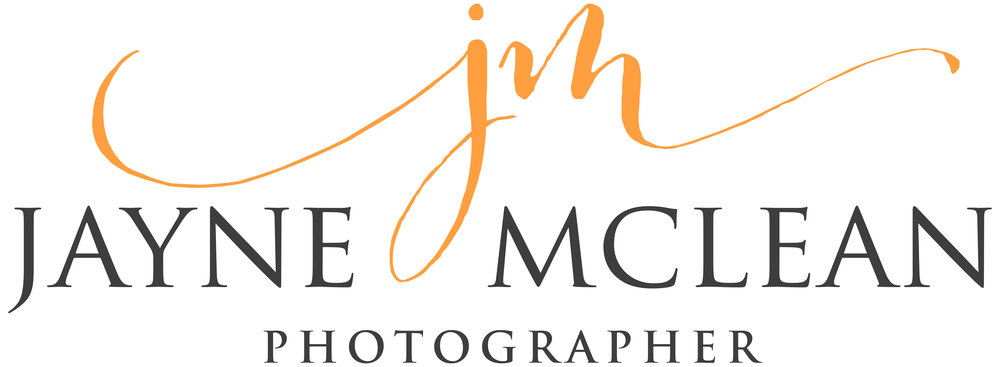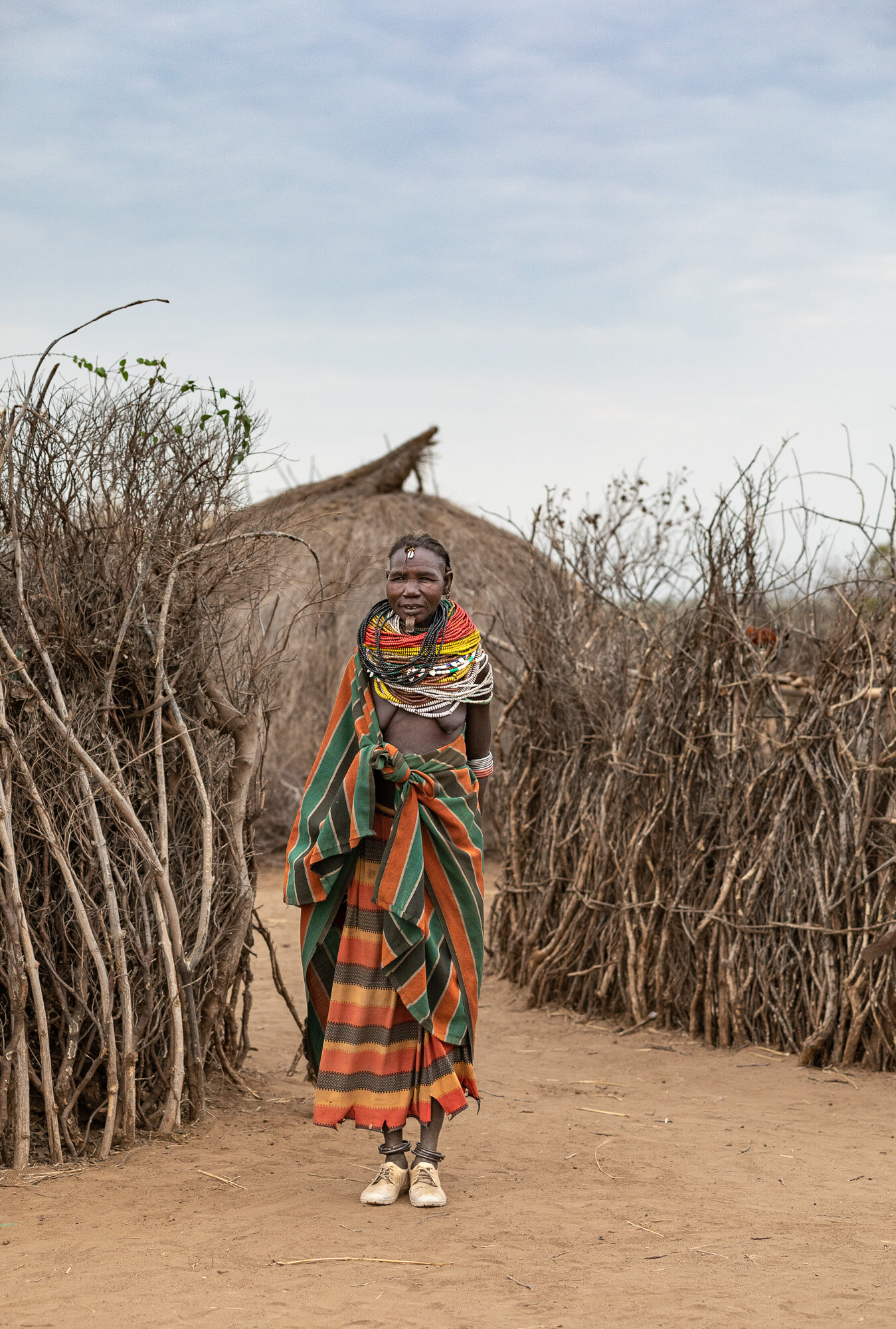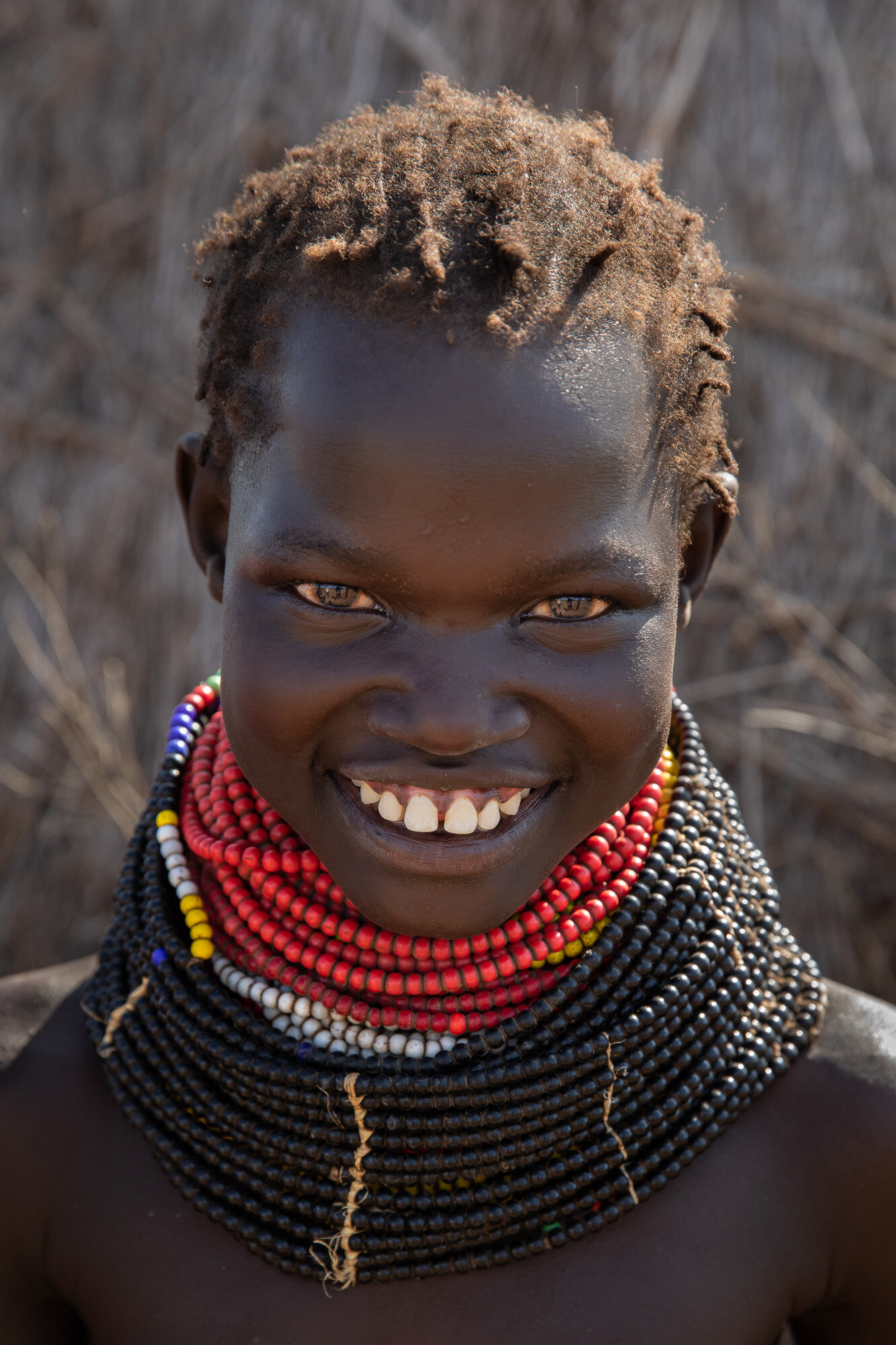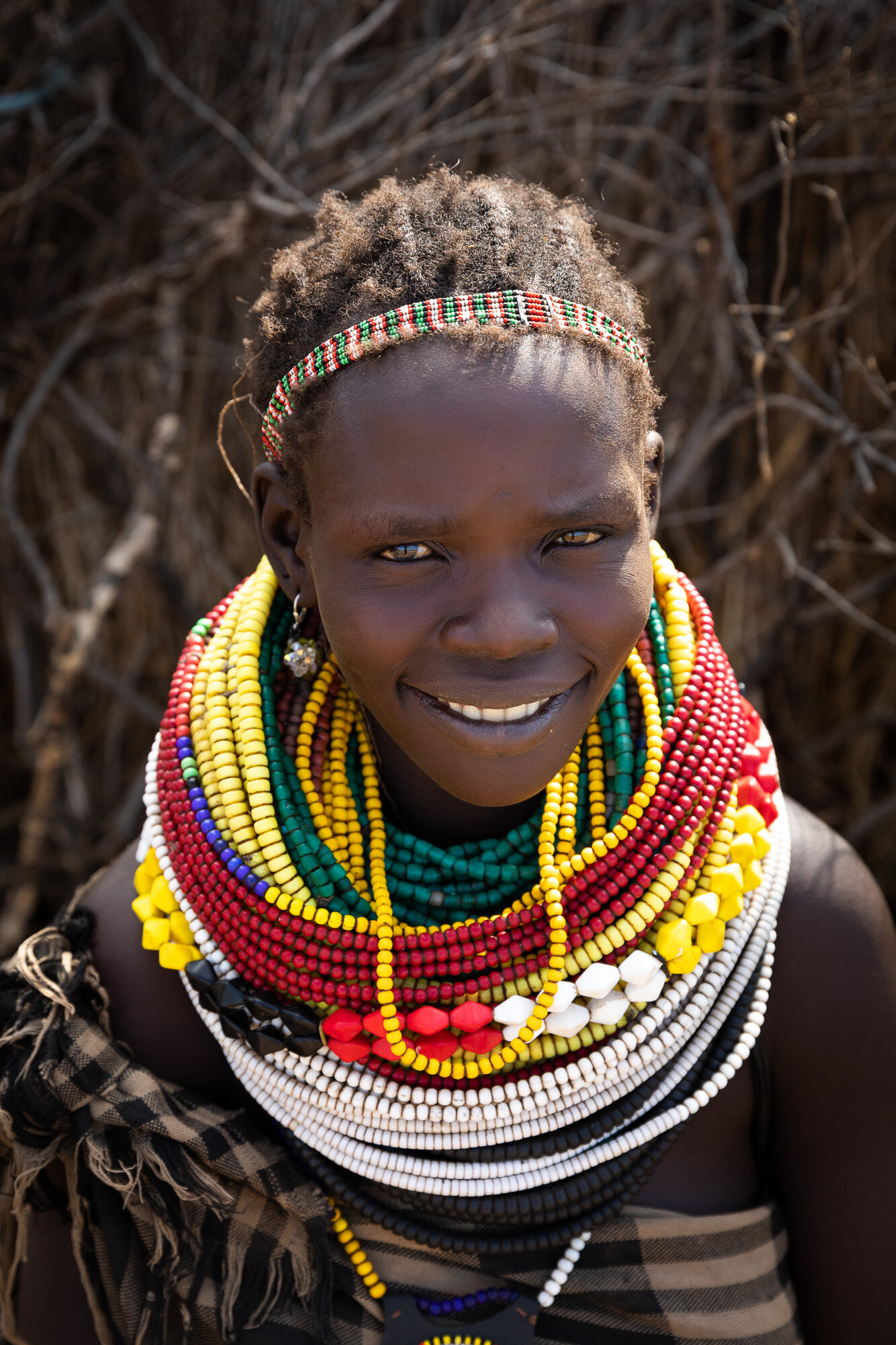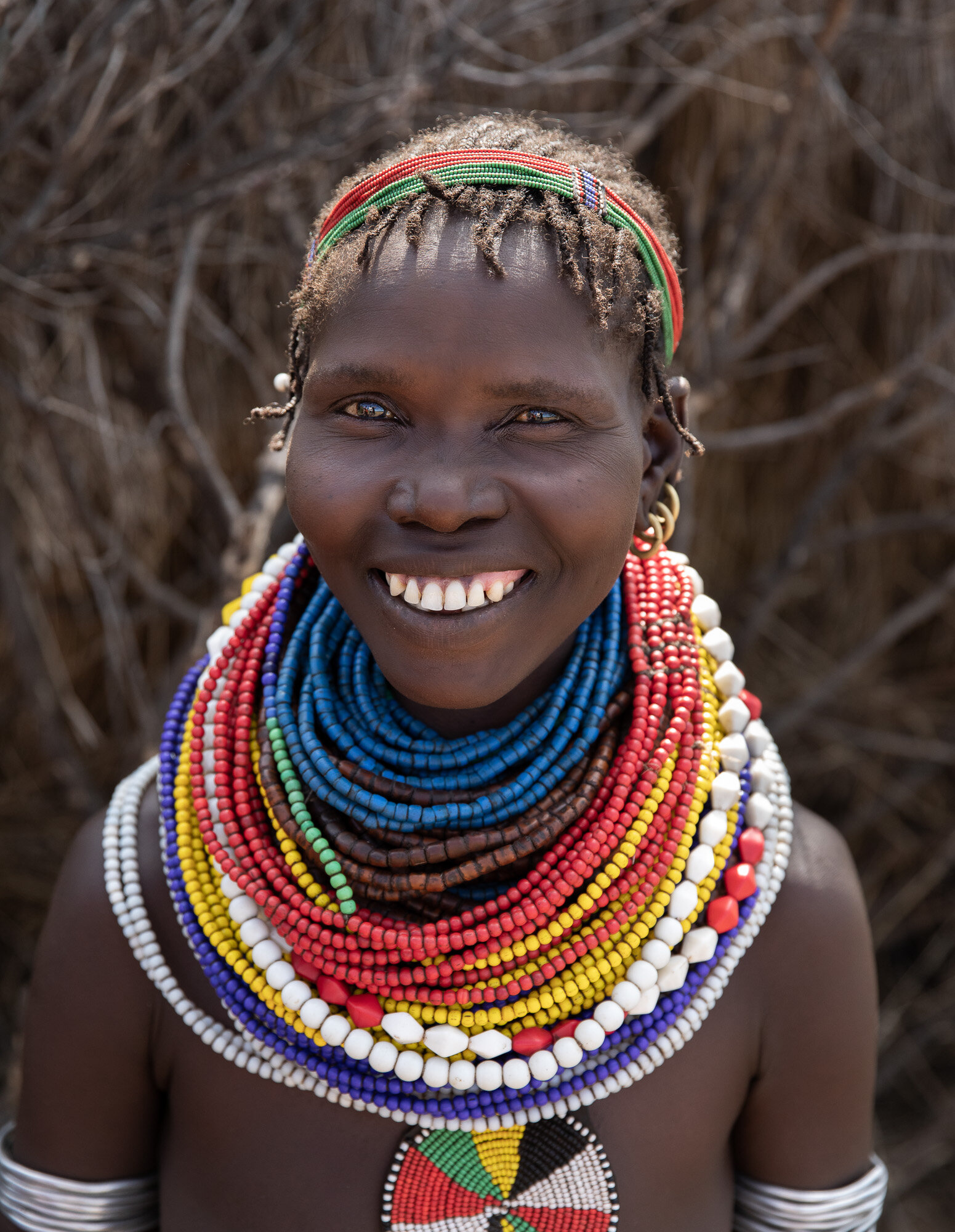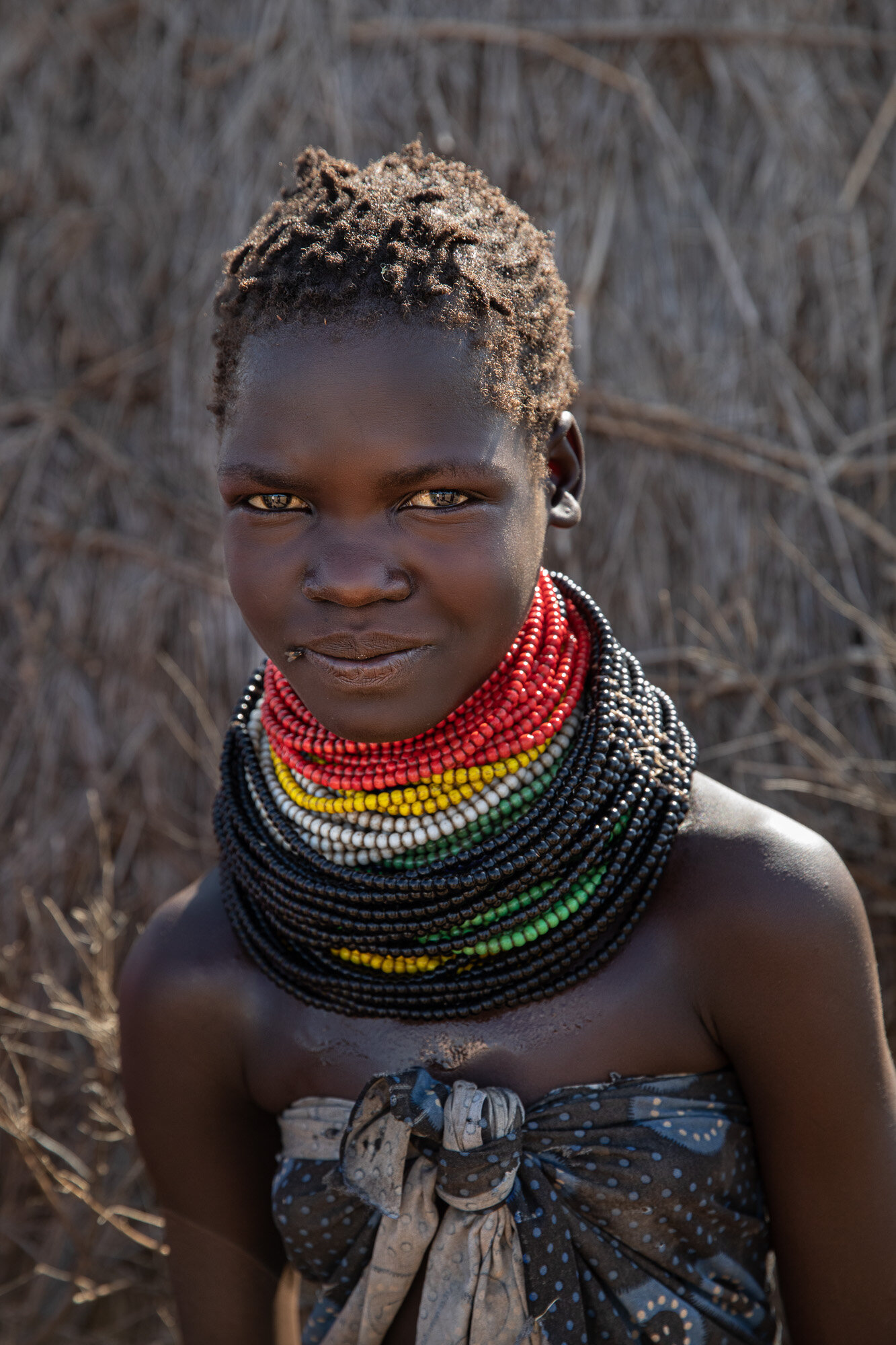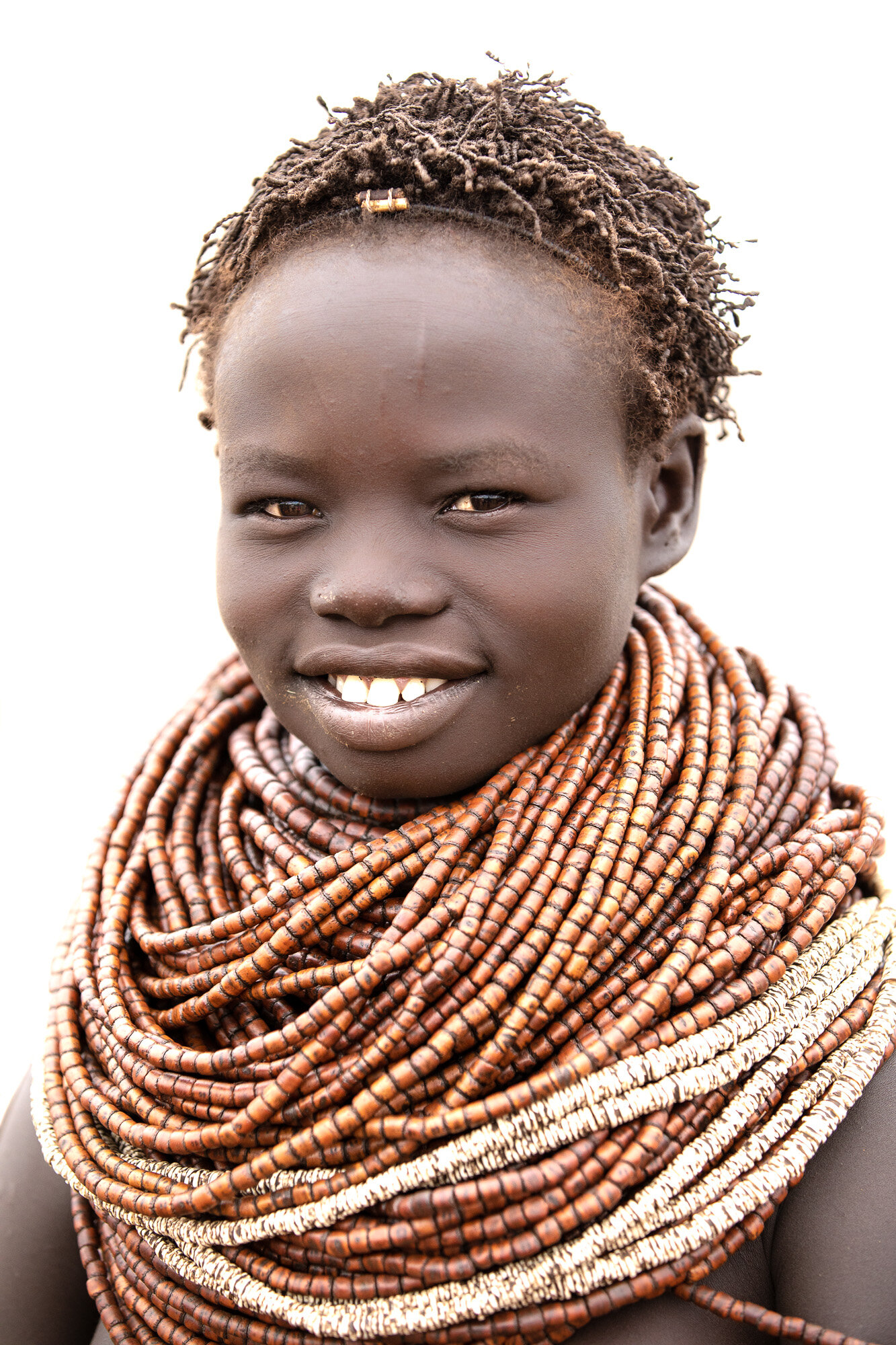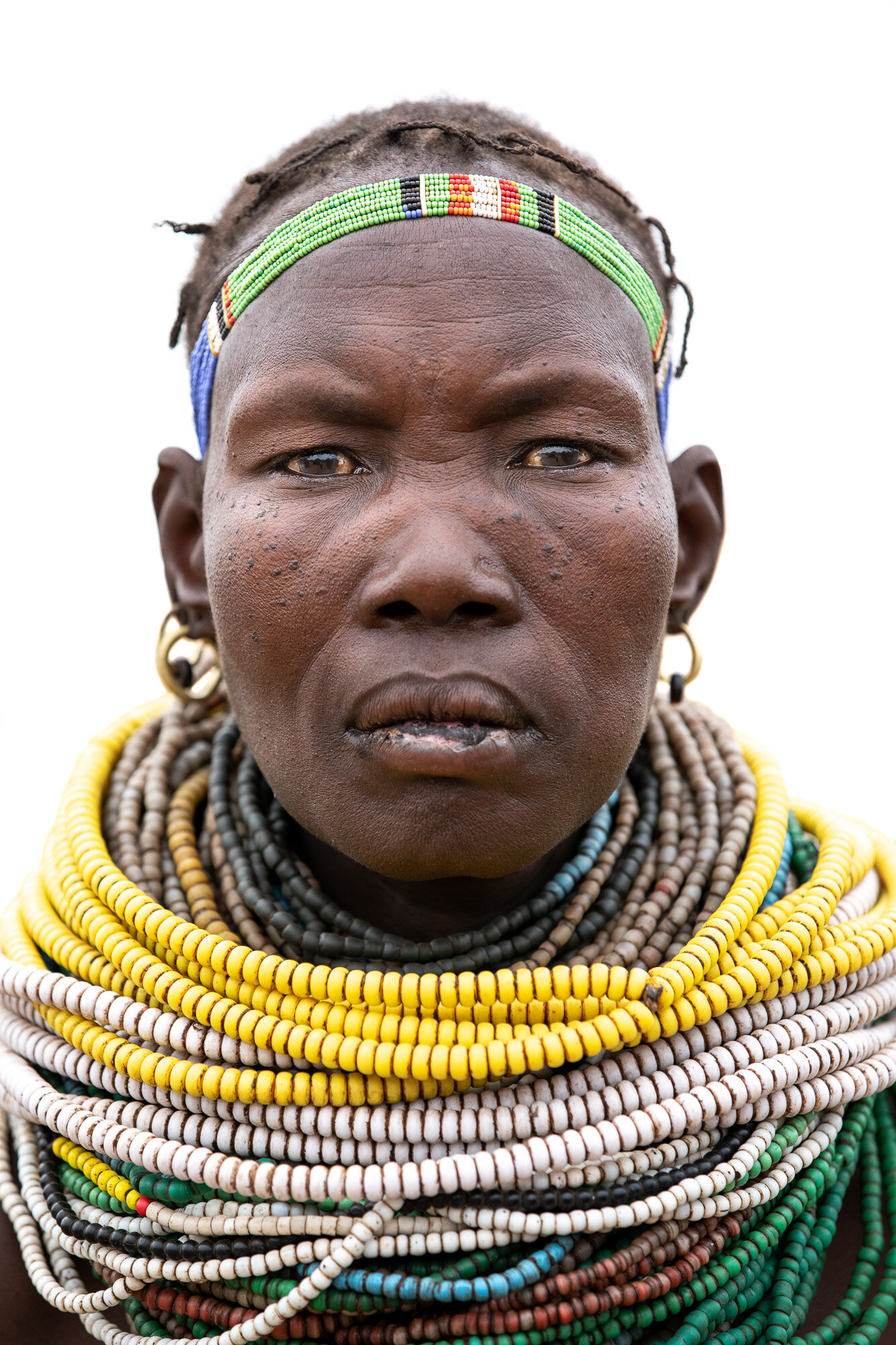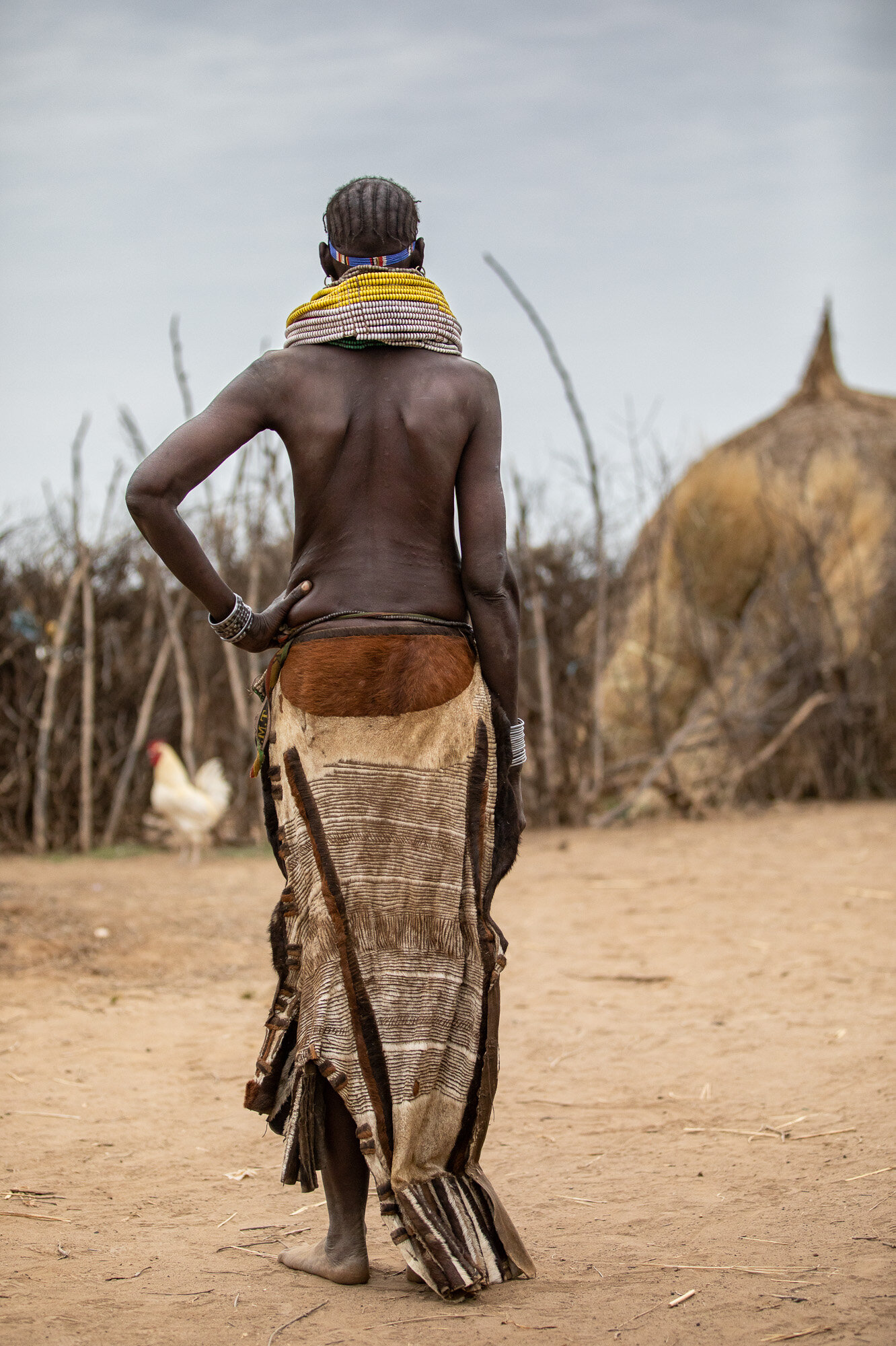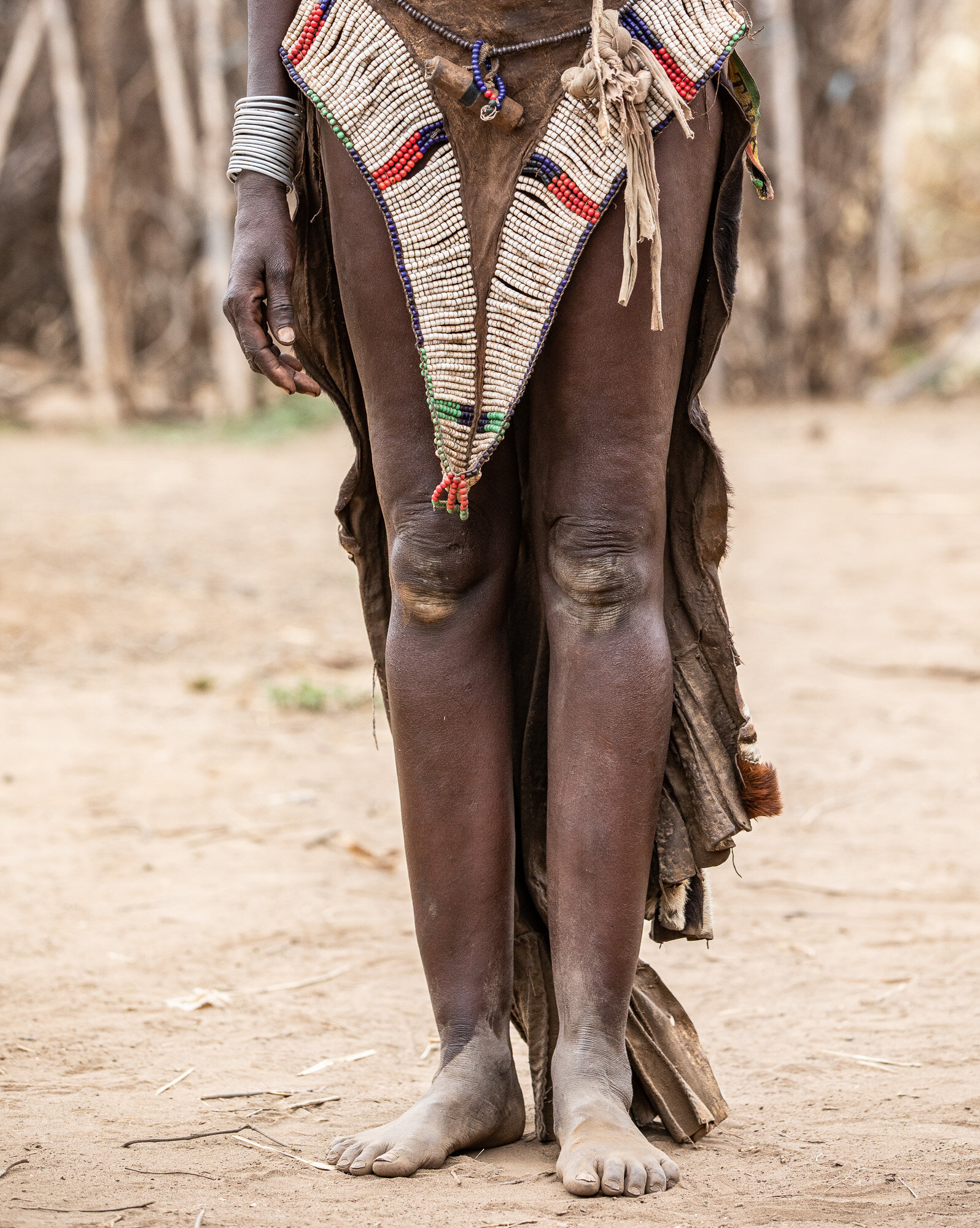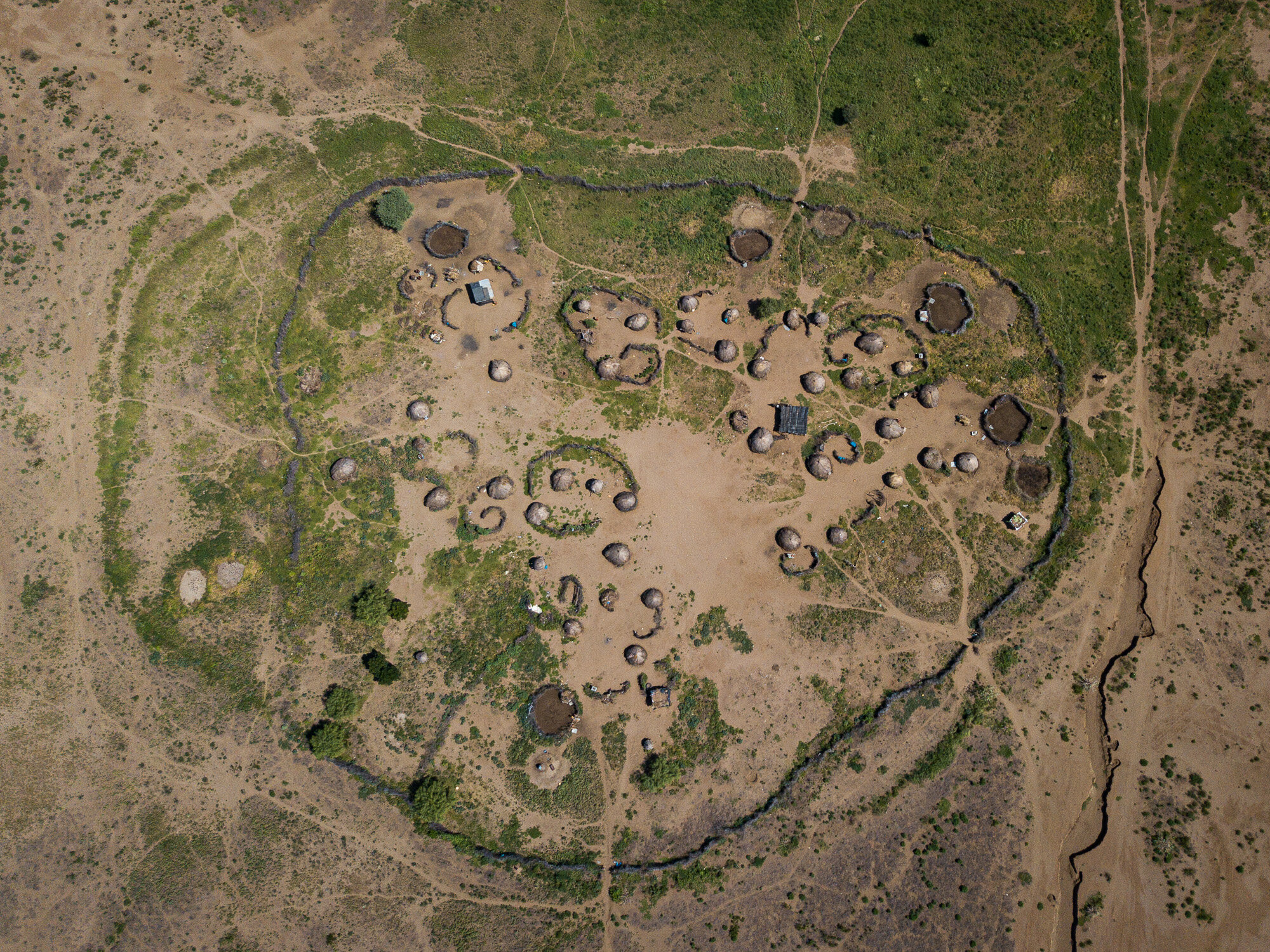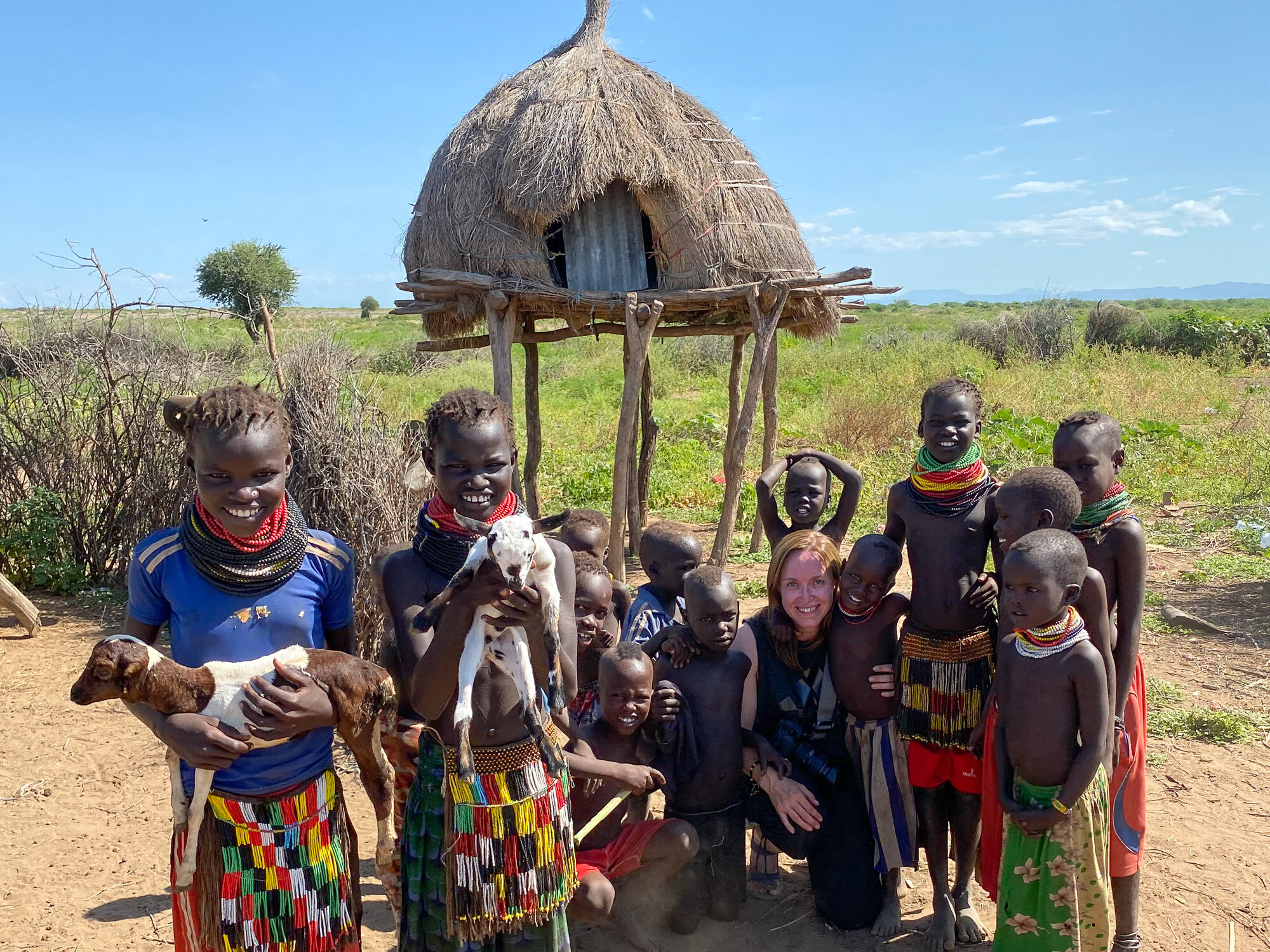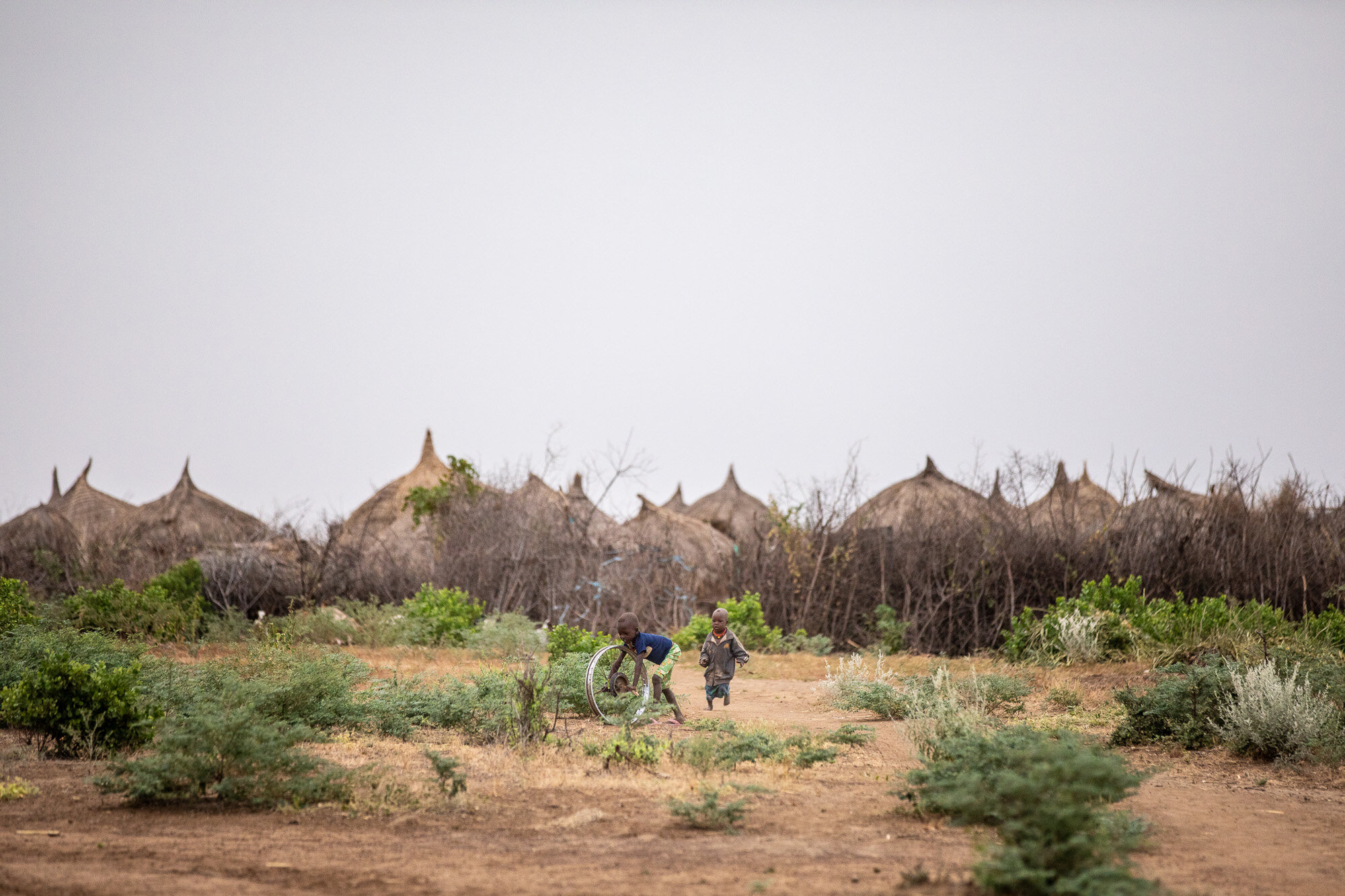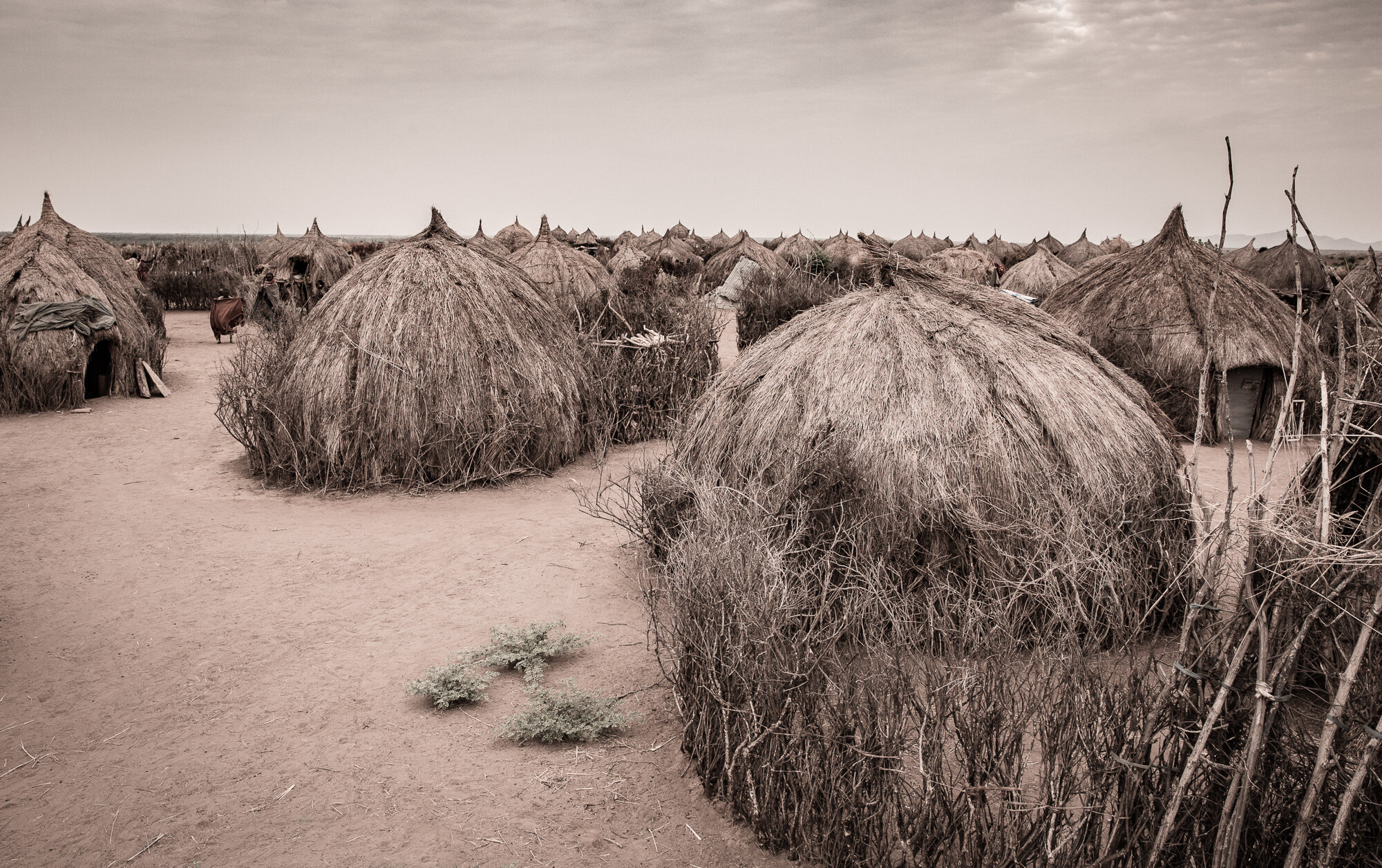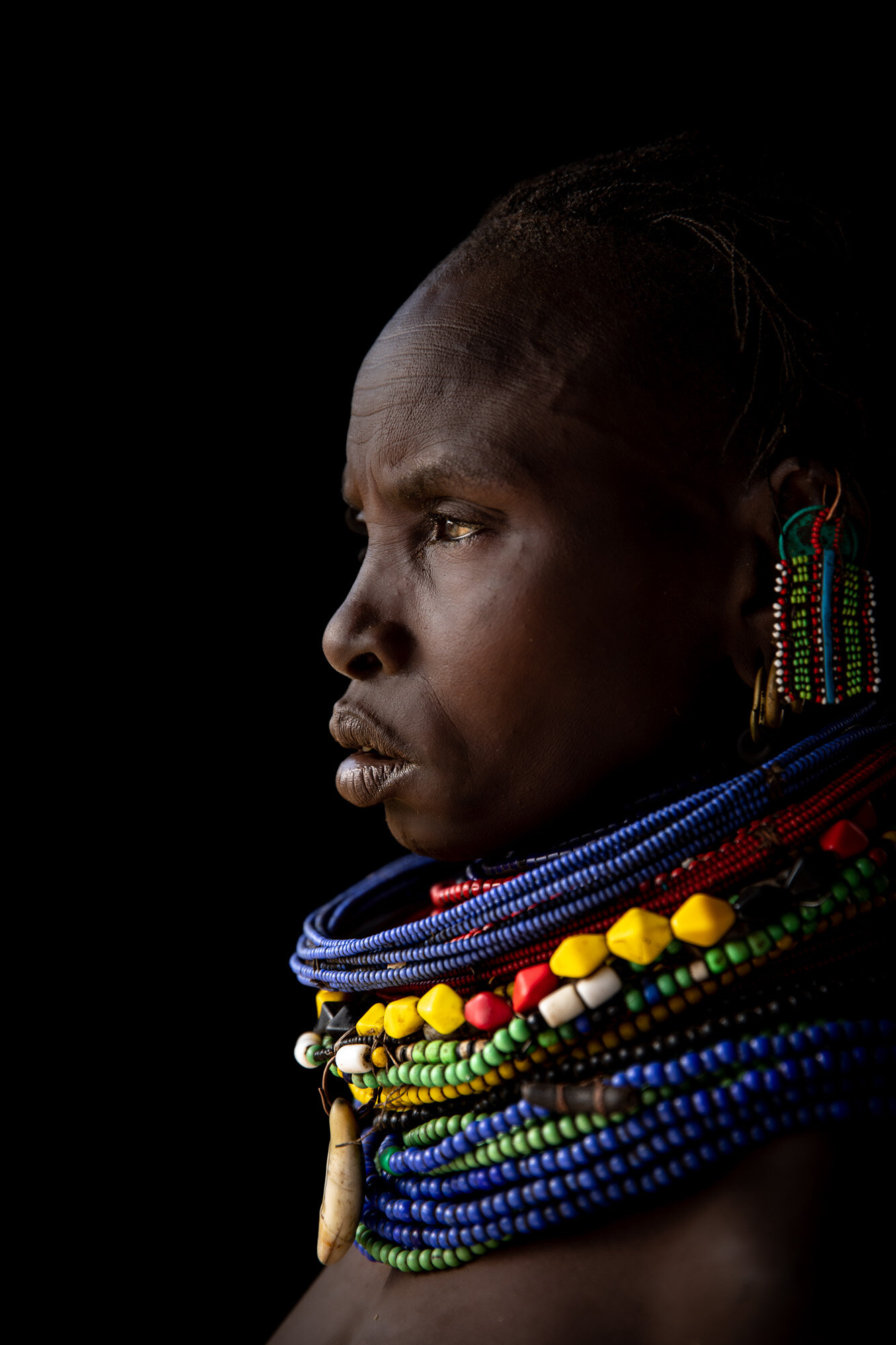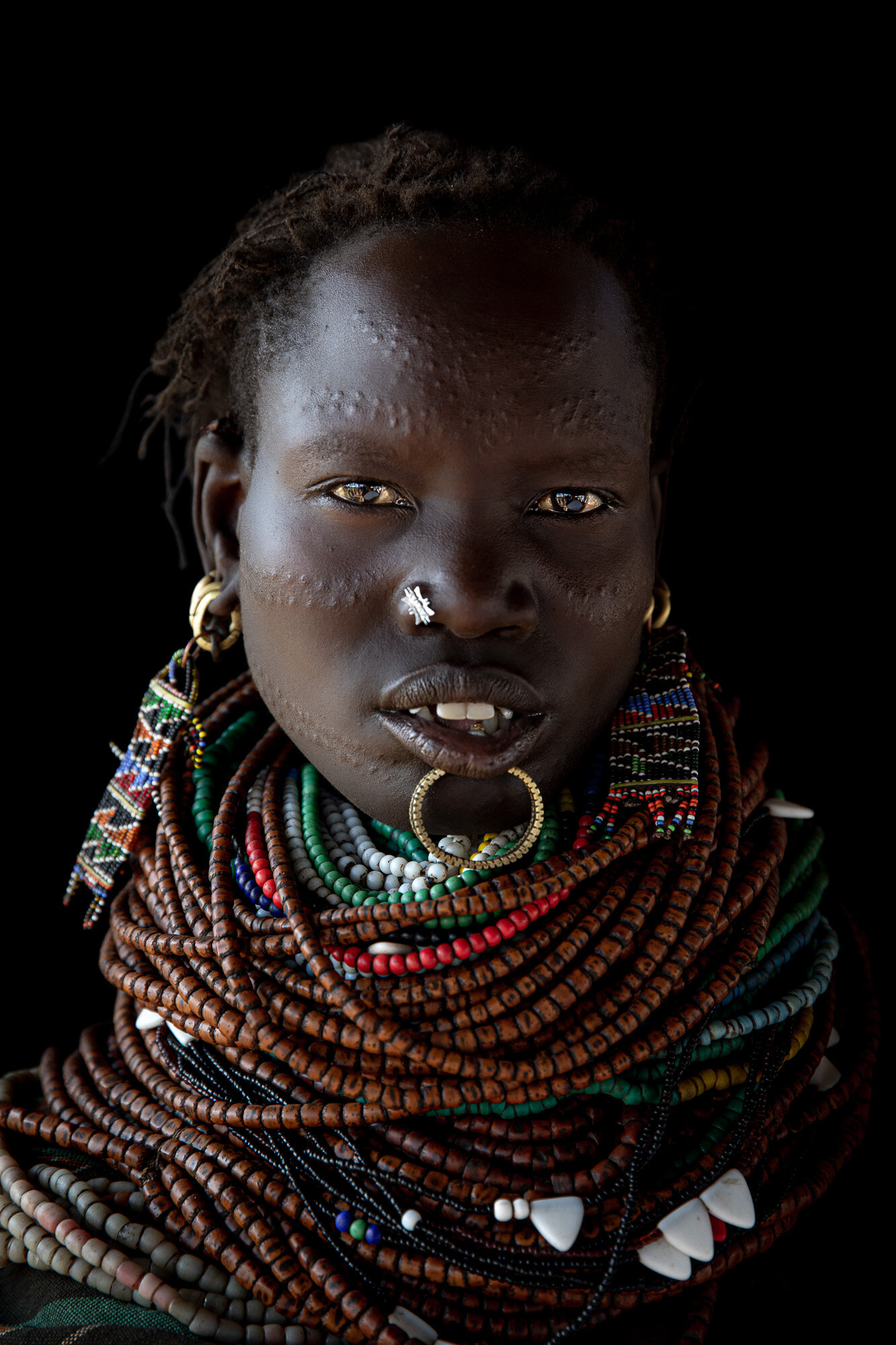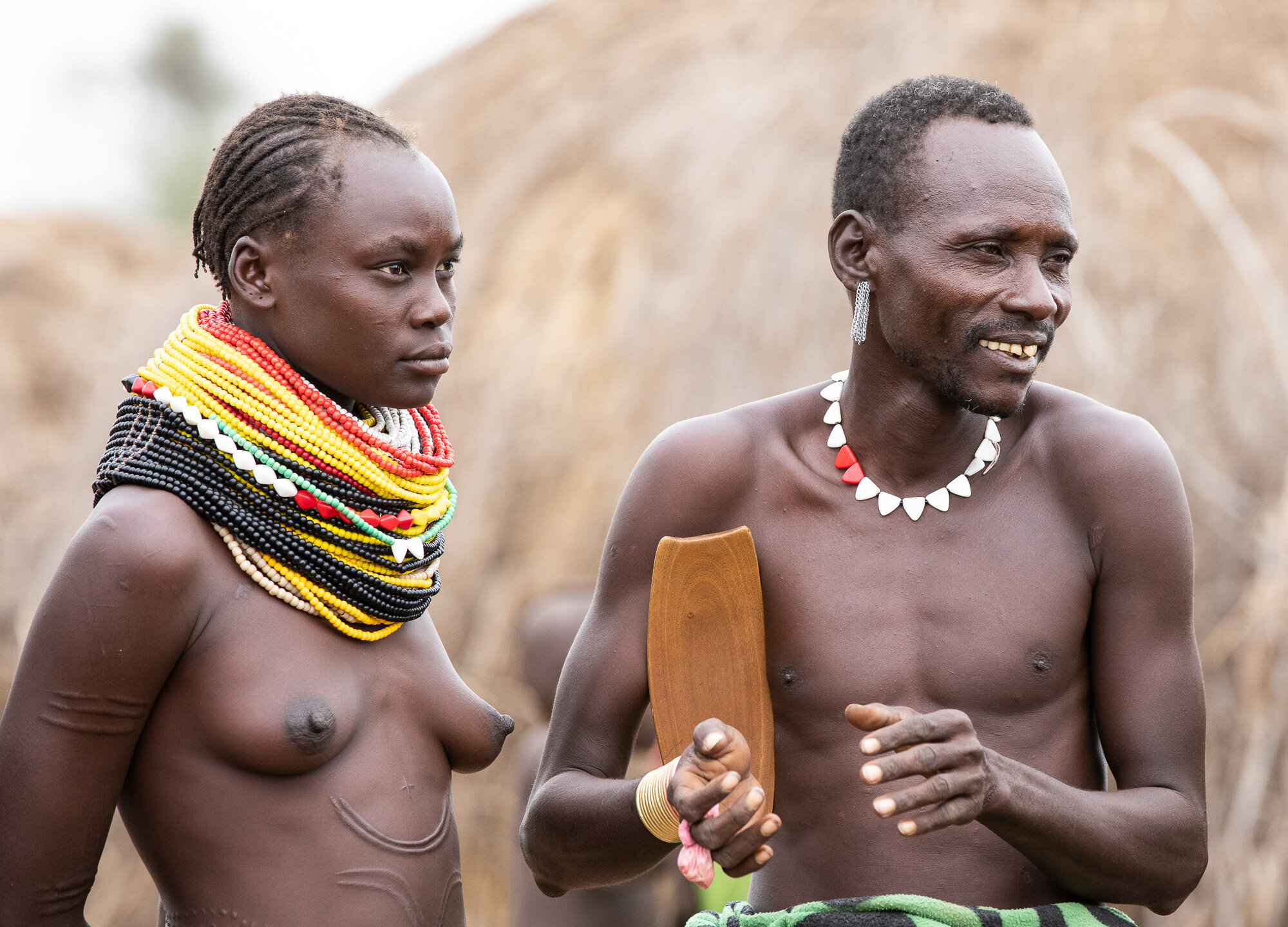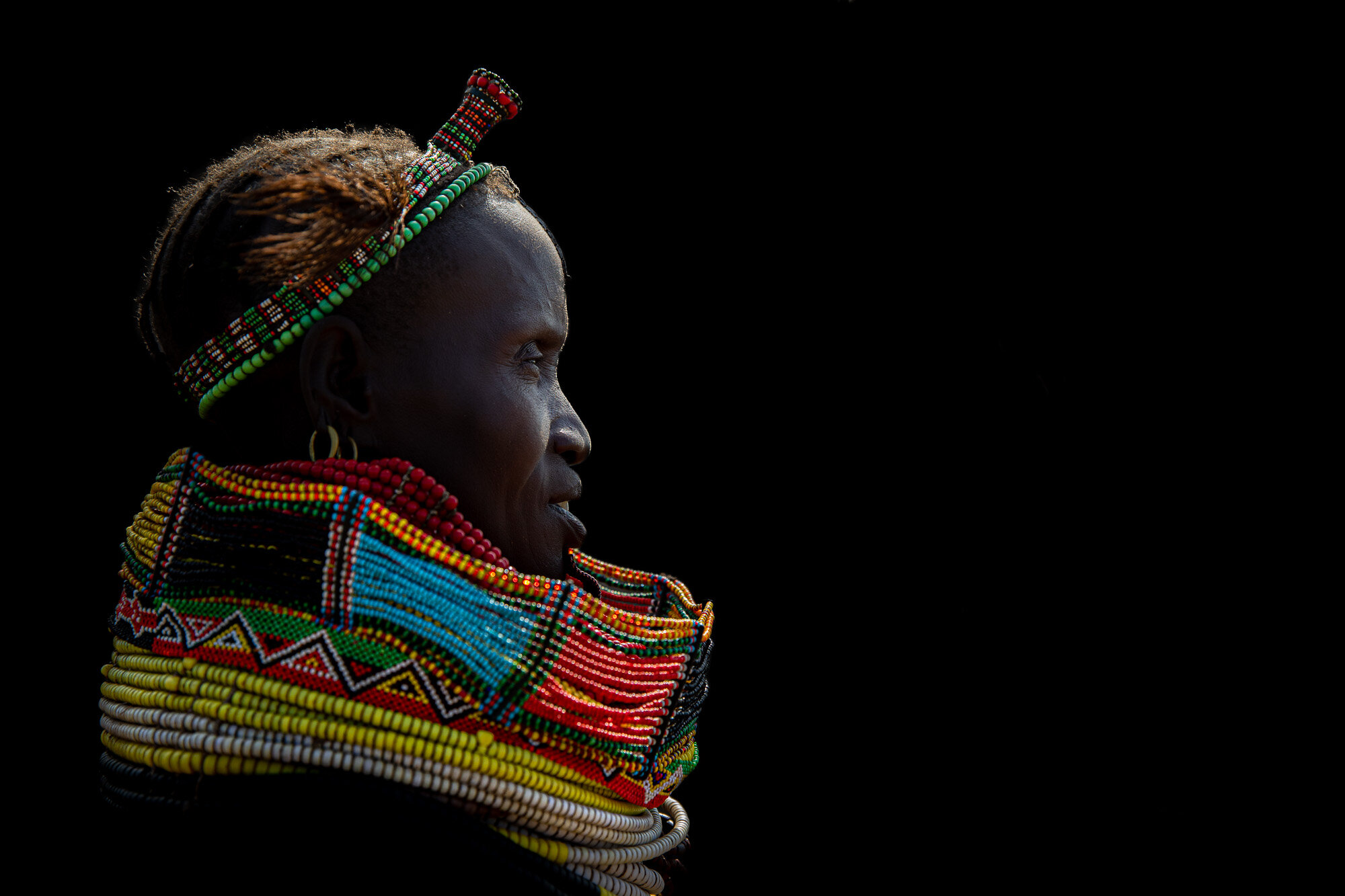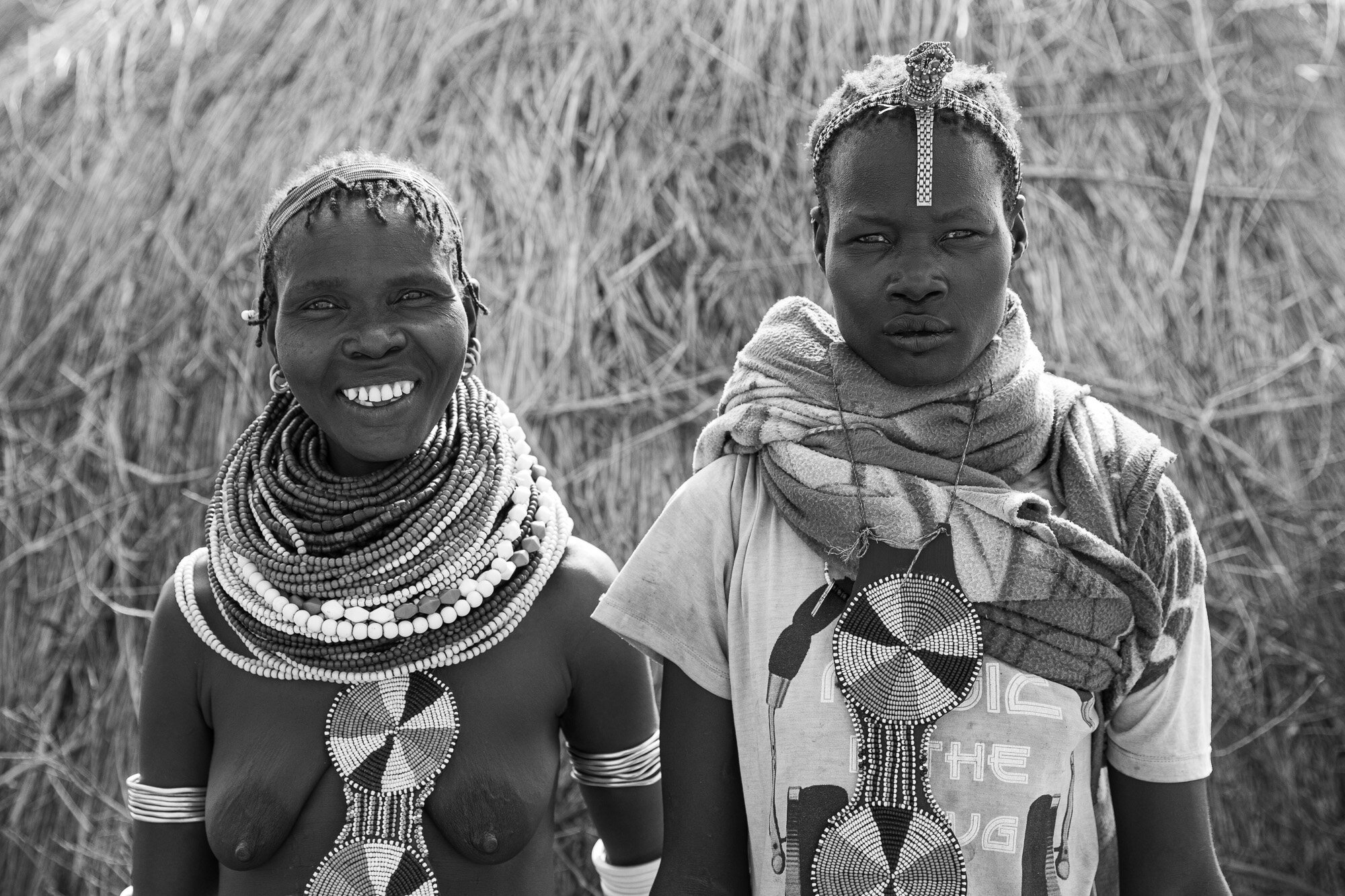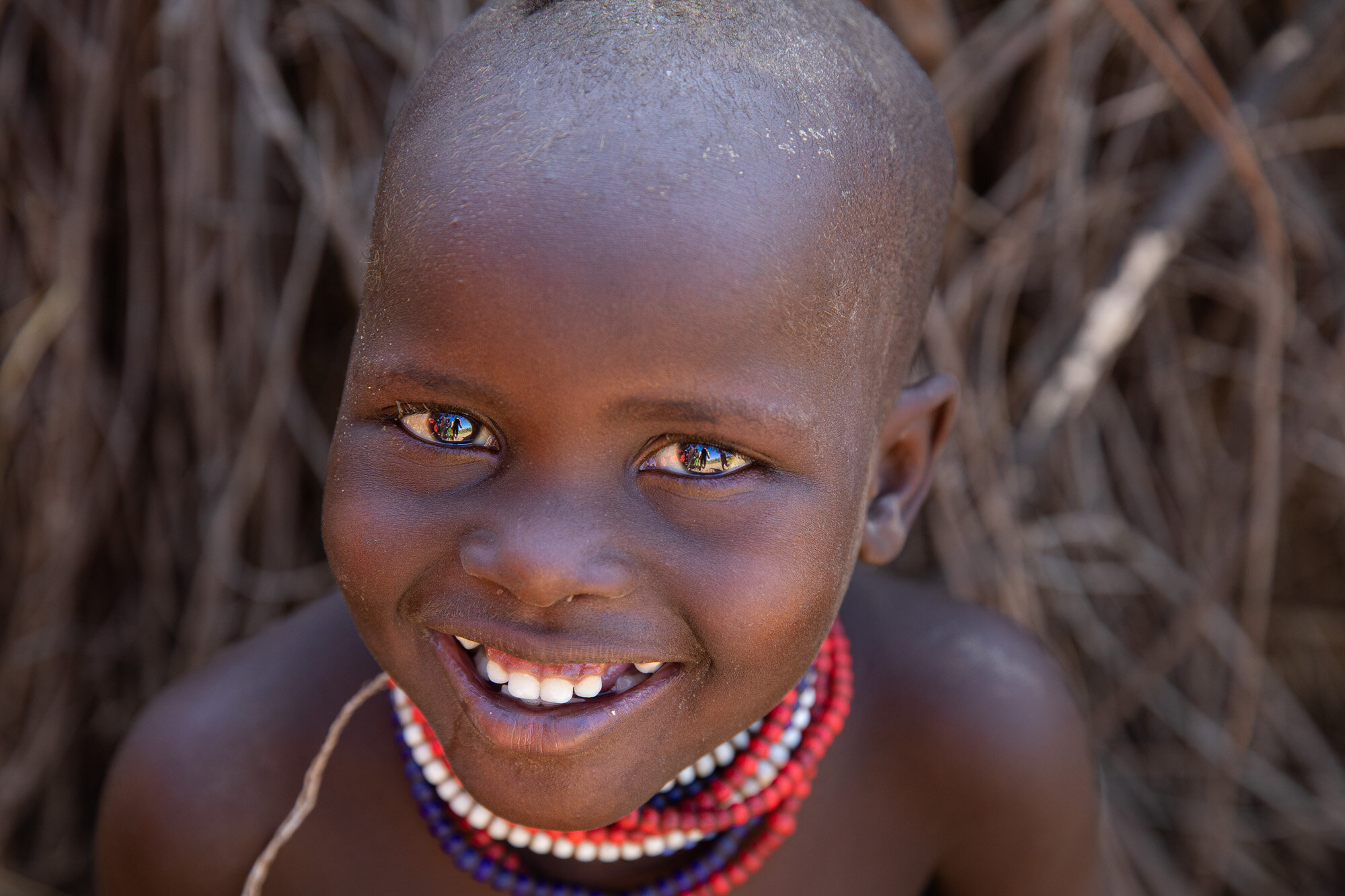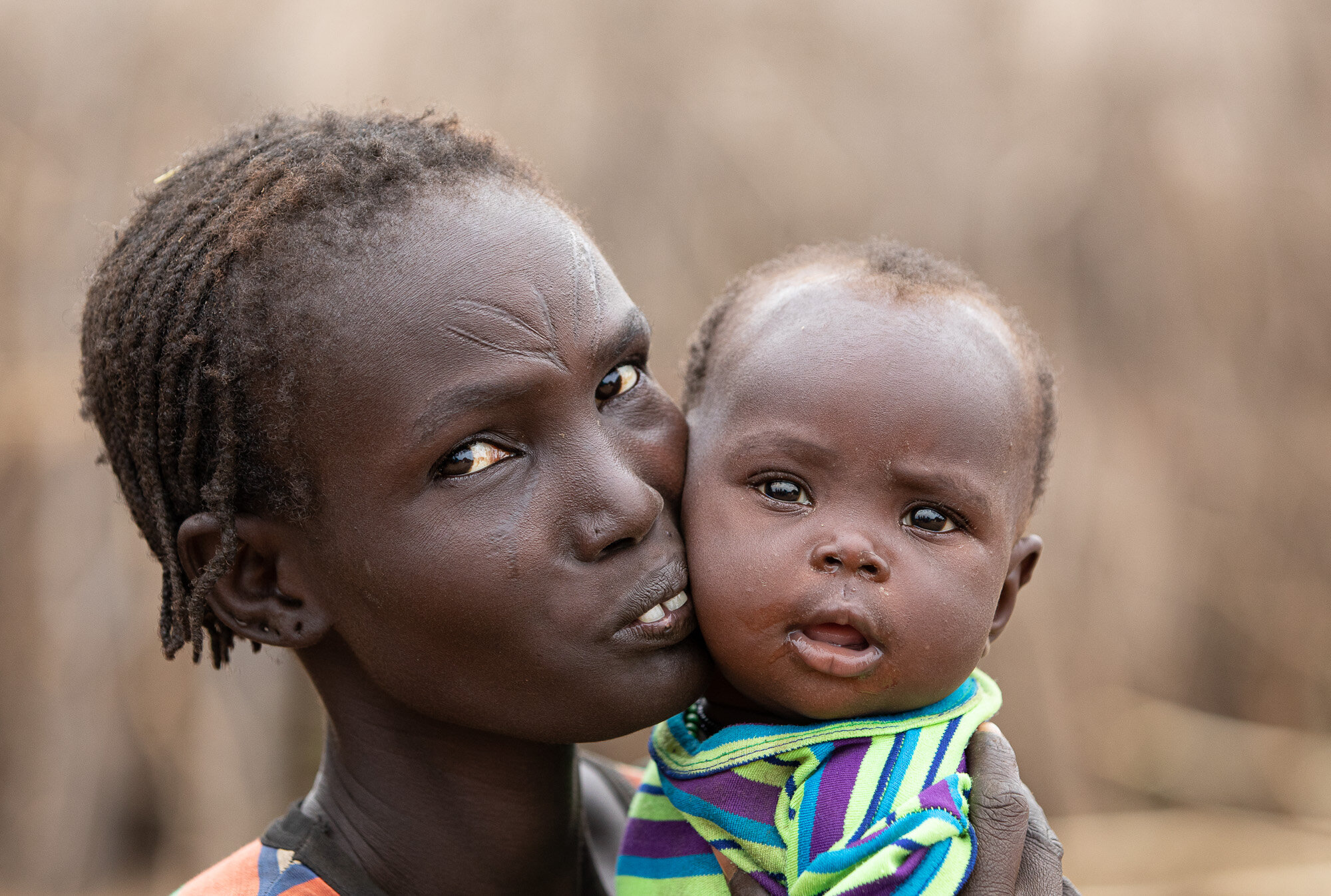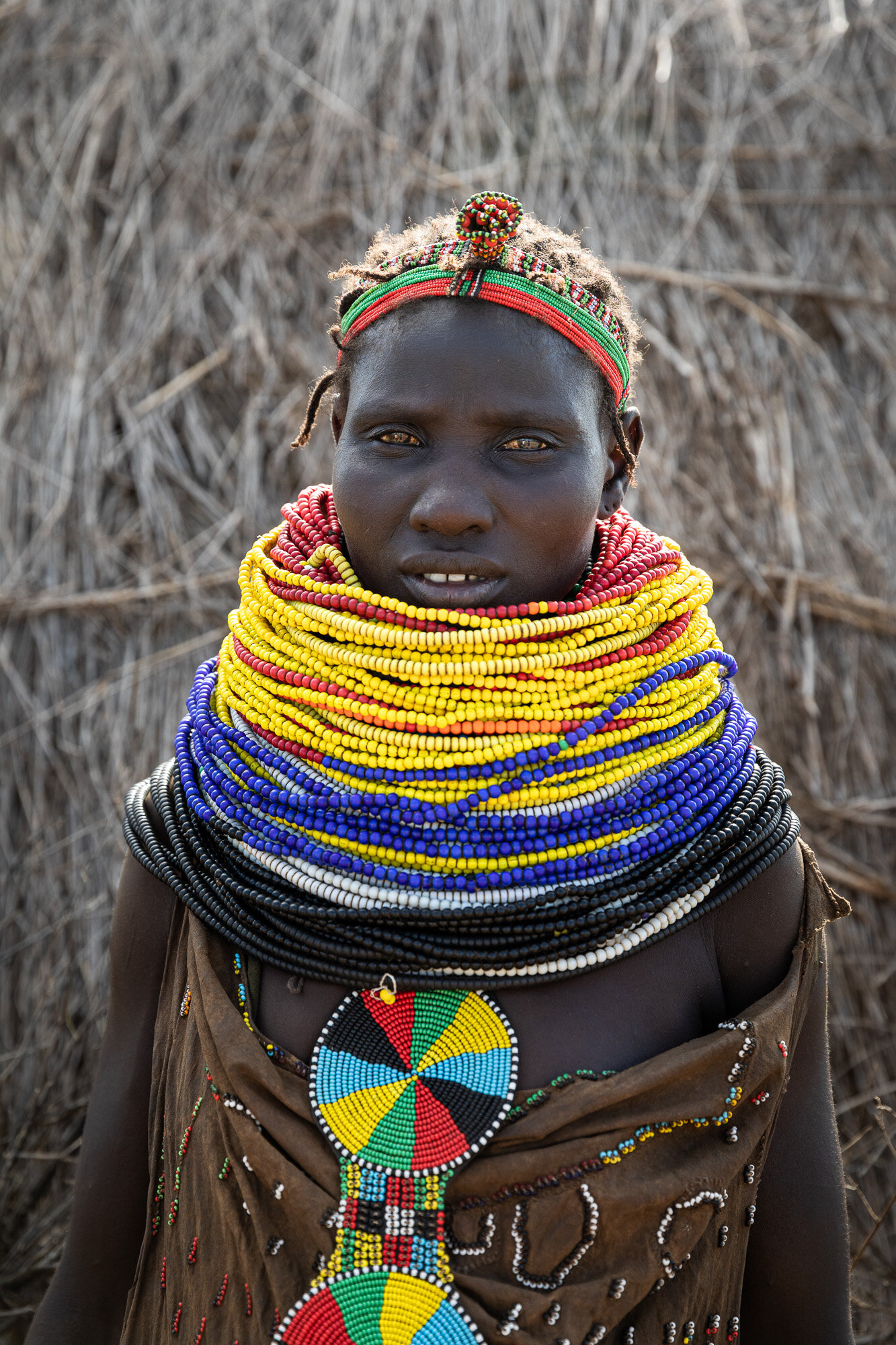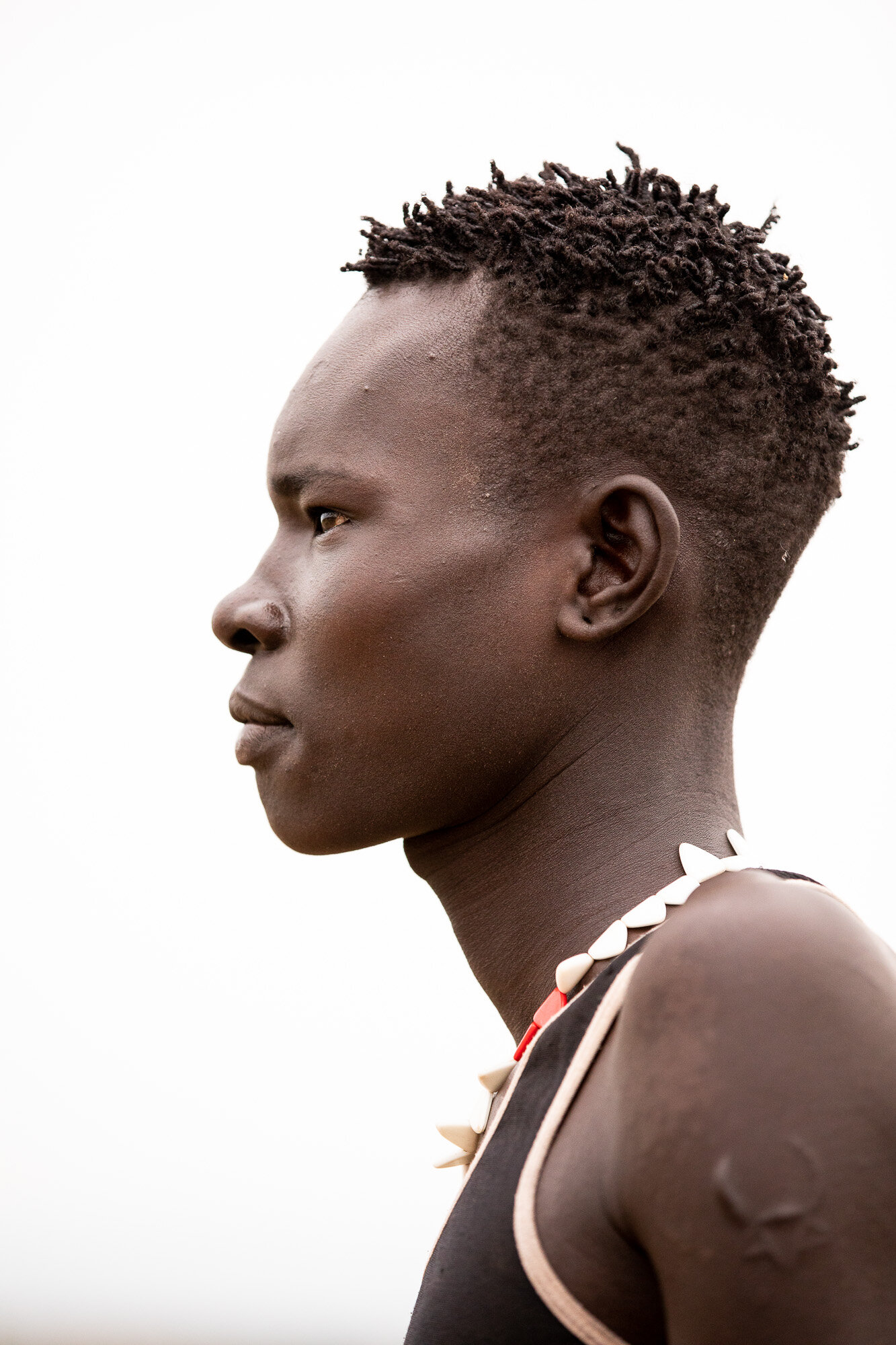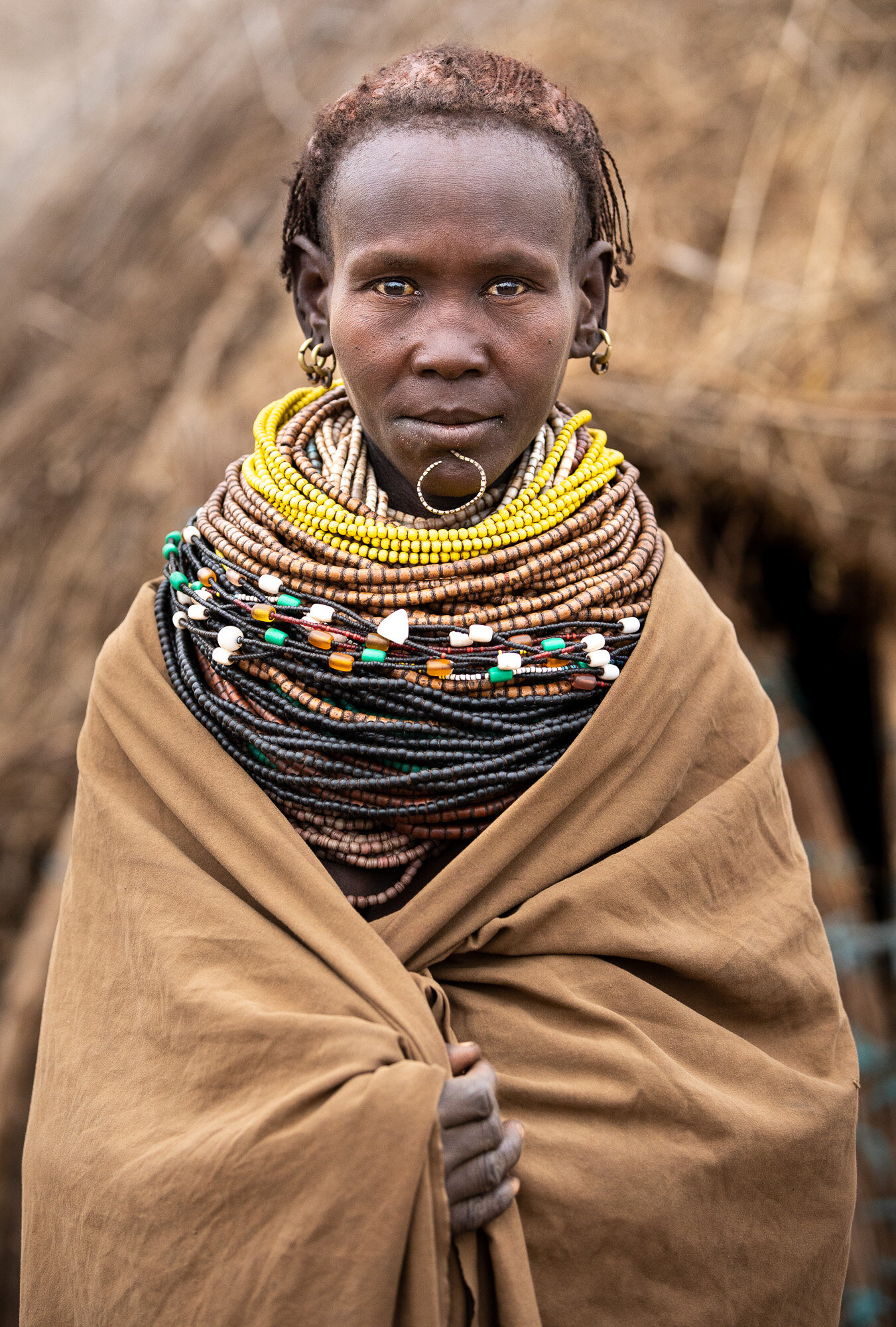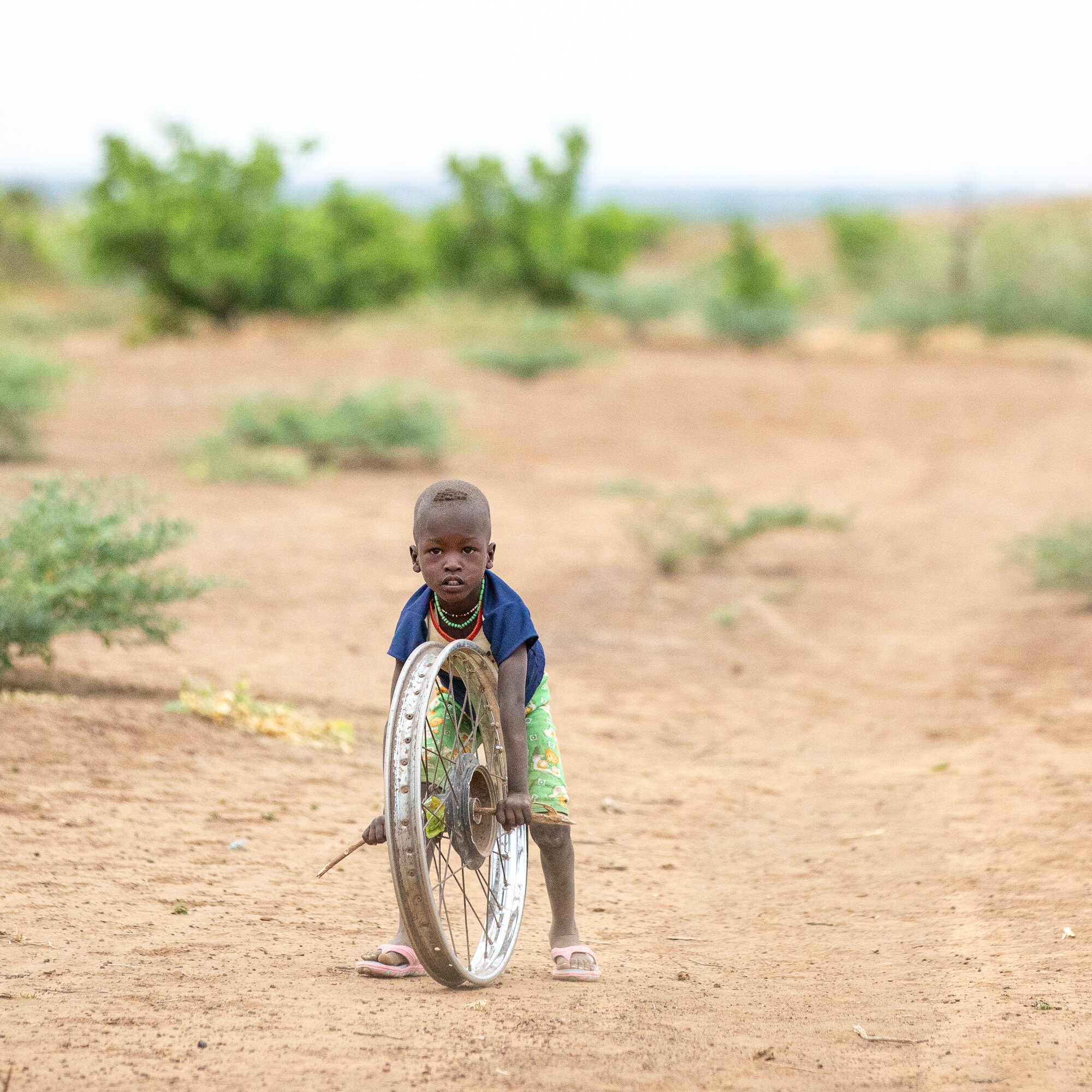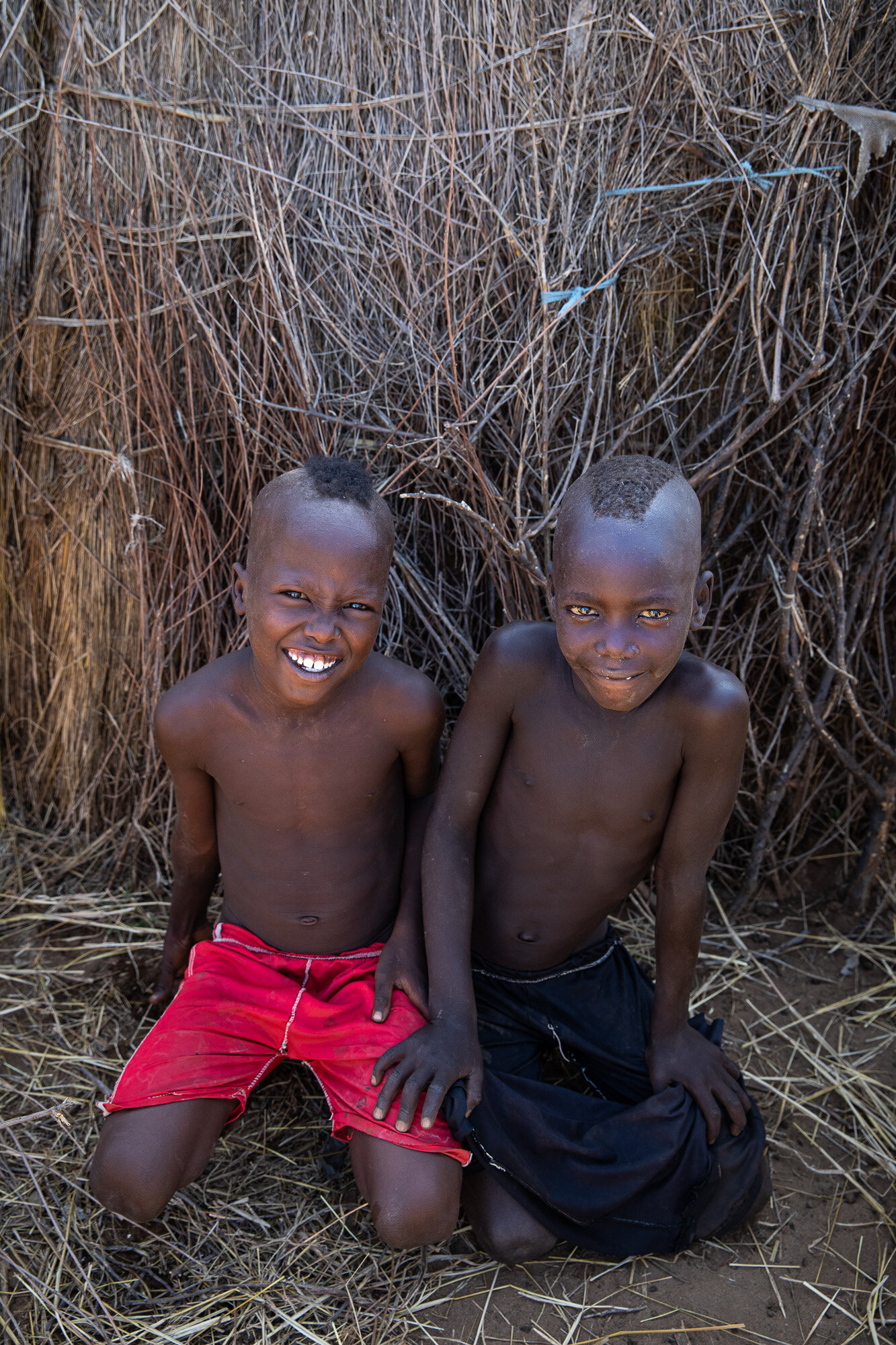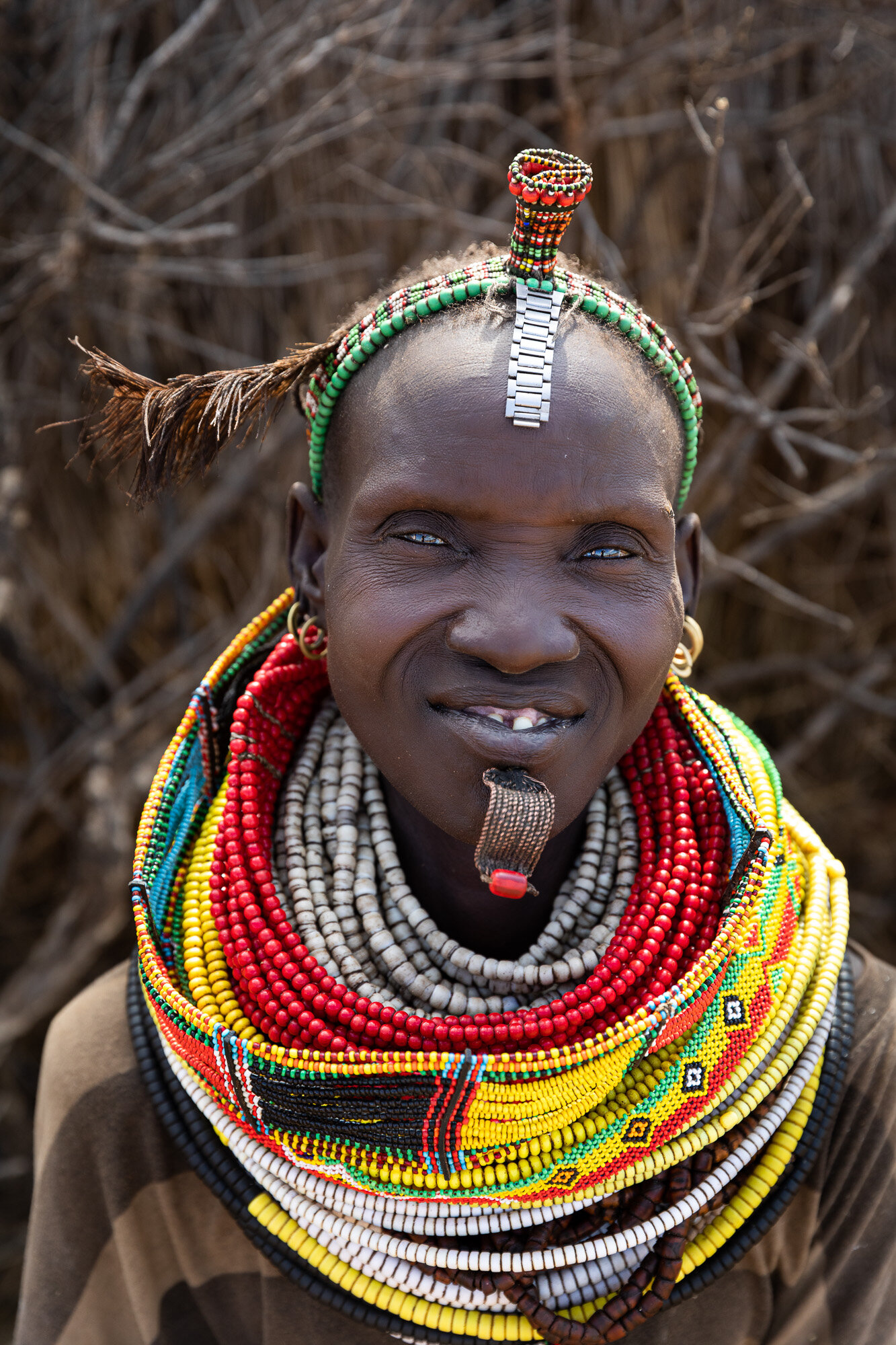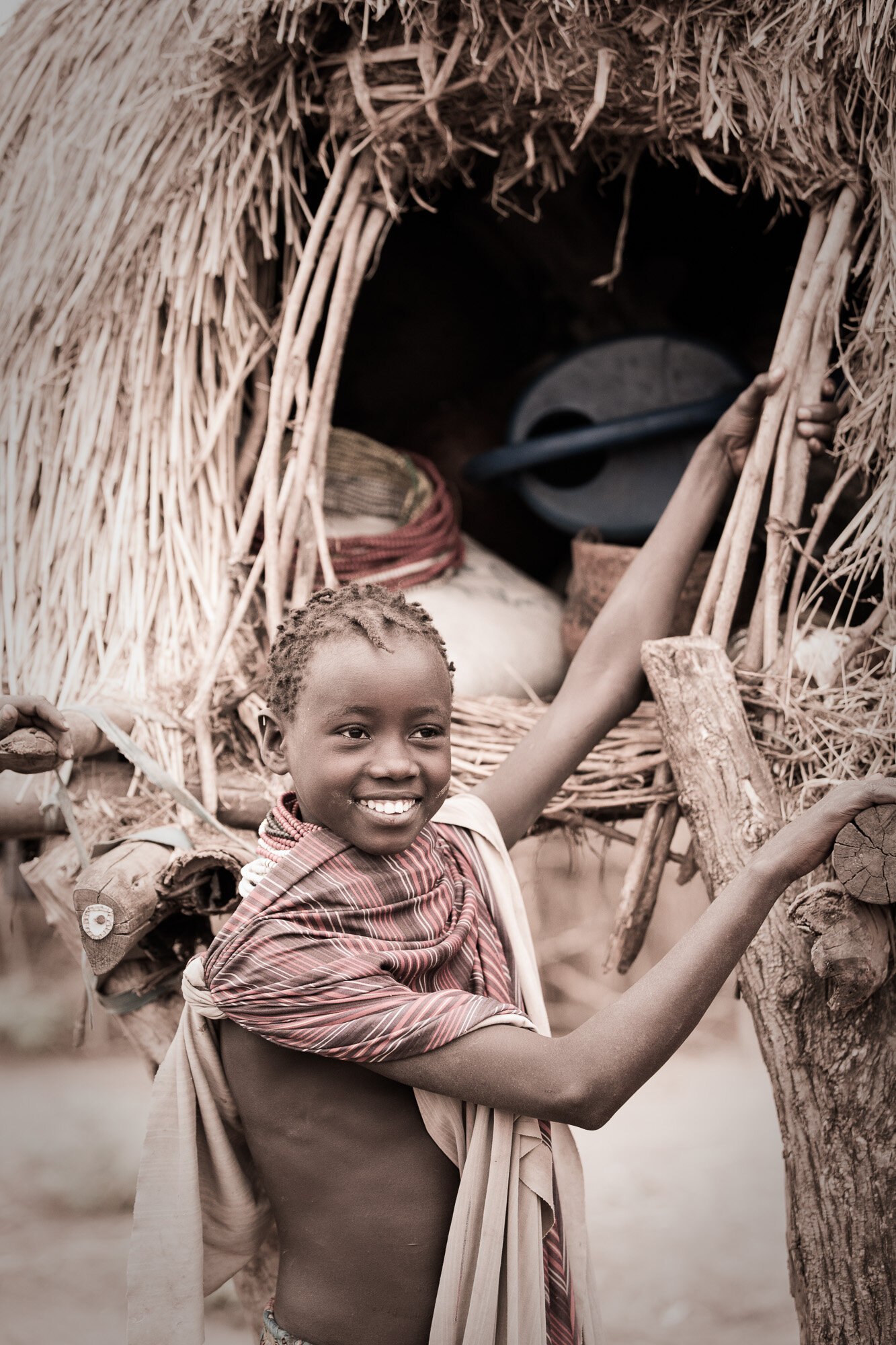A remarkable tribe to visit on an Omo Valley photo tour
After leaving the Omo Valley town of Turmi in Southern Ethiopia, your 4x4 will head west closer to the Kenyan border towards Kangaten (also spelt Kangatin). Kangaten is the closest town to the Nyangatom ethnic group in Southern Ethiopia. A few more bumpy dirt roads and you start to see a Nyangatom tribal village ahead with the curved line of vertical branches appearing upon the horizon. Parking near the entrance to the Nyangatom tribal village as you emerge from the car with cameras in hand you will start to see many little faces with curious eyes appearing and getting closer to you. Whilst the Nyangatom have a reputation as feared warriors they are one of my favourite Ethiopian tribes to visit on an Omo Valley photography tour.
THE NYANGATOM ARE ALSO KNOWN AS DONYIRO AND BUME TRIBE
Donyiro was the original tribal name of the Nyangatom people. Rival tribes nicknamed them Nyam-etom which means “elephant eaters”, however the clever Nyangatom changed this name slightly to the current Nyang-atom which means “yellow guns”. The Nyangatom are part of the Karamojong collective tribal group with the Topasa, Turkana and Karamojong tribes. The Nyangatom tribe arrived in Southern Ethiopia after their migration from Northern Uganda. They now live in the Lower Omo Valley in Ethiopia as well as South Sudan.
The Nyangatom tribe are also known as the Bume tribe, however this was initially a derogatory nickname from their neighbouring Suri tribe. Bume meaning “those who smell bad or stinky ones”. Whilst some people still refer to them as the Bume (Bumi) people, Nyangatom is more commonly known and respected.
the Nyangatom tribe live in the lower Omo Valley, ethiopia
In southern Ethiopia the Nyangatom tribe live near the town of Kangaten on the West side of the Omo River and further towards Kibish. They are bordered by ethnic groups on all sides which has resulted in many devastating tribal conflicts with the neighbouring Suri tribe, Dassenech tribe and Turkana tribe. However, when you visit their villages on an Omo Valley photo tour they are one of the friendliest and welcoming tribal groups in Southern Ethiopia.
The resources on their land are scarce and the effects of climate change impact them and their food security. The droughts, irregular rainfall, tribal raids and conflicts have all contributed to the harsh environment that they live in.
When you drive towards a Nyangatom tribal village in Southern Ethiopia you initially see the branches that create a boundary and offer the village protection. During the evenings the gateways are closed with thorny branches.
beaded necklaces of the Nyangatom women
The young girls are given a beaded necklace by their fathers. On special days, occasions or ceremonies the girls receive more necklaces. The more necklaces the better and when they are married they also receive more strands of these wooden, glass or plastic beads. The quantity, quality and type of beaded necklaces are representative and symbolic to the women’s social status.
The multitude of heavy necklaces are traditionally not removed unless the women are washing them. They are worn day during the day and when they sleep and can weigh more than 5kgs. Originally the necklaces were made from dry seeds but now they are mostly plastic beads from Kenya or wooden beads.
Body Scarification of the Nyangatom Tribal Women
Body ornaments and scarification are also symbols of status and strength. Body scarification for the women is practised similar to the Suri tribe, with it being a sign of creativity, individuality and beauty. As with many of the other Omo Valley tribes the men have scars on their upper bodies after they kill an enemy to release the bad blood. It is an intimidating sign to others that they are a warrior who has killed and they take pride in this highly visible sign of their masculinity and strength.
A Nyangatom women’s body scarification from the Omo Valley, Ethiopia.
A razor or thorny bush is used to cut the skin before ash is rubbed into the wounds to create the raised scarring.
Body scarring is visible around this Nyangatom woman’s belly.
This young Nyangatom tribe girl already has body scarring and many beaded necklaces.
The Nyangatom tribal women wear long skirts from goat skins. Some are decorated with beading and embellishments. Together with their layers of beaded necklaces it provides information on their social status, place in their African tribal village as well as age and marital status. When they are married they wear different skirts. The skirt in the photo below indicates that this women is married.
The Nyangatom are one of the many tribes in Ethiopia that have a varied mix of western influences mixing within their clans. However, the Omo Valley tribes remain relatively unchanged and are true to their culture and symbolic traditions.
In the Nyangatom culture all women must wear necklaces. However you can see from the photo above that two of the women are not wearing necklaces or traditional clothing. These women have chosen to dress like the “township style” of Kangaten rather than follow the traditional path.
The nyangatom men and women have defined roles
The men in this Ethiopian ethnic group all carry the mandatory “stool” which is also used as a “head rest” as well as a weapon such as an AK47. The Nyangatom were one of the first Omo Valley tribes to access guns over the border from Sudans civil war. The Omo Valley has since become full of guns, with old AK47’s being carried over the shoulder as a status symbol of many of the tribal men much like a handbag. Some even hide their folded up cash in their guns!
The Nyangatom elders mainly stay at their villages during the day. Sitting on their wooden stools or using it as a head rest when lying down.
Whilst the elders usually stay near the village, the younger men look after the livestock. They can be absent from their villages for quite sometime when they need to move the goats and cattle depending on the security conditions and environment. The Women and girls milk the livestock when they are in the village, look after any crops, prepare and cook meals and build the huts and village structures.
Like with the other Omo Valley tribes the older girls look after the younger children and babies and the younger boys help with protecting the crops before they start to look after the livestock with the older boys and men. When you visit a Nyangatom tribe village you will see that everyone has a role/job which depends on their age, gender and social status.
Typical to most African tribal villages the girls look after the younger children.
Nyangatom tribal marriages
The Nyangatom daughters and sisters lives are mostly controlled by their fathers and brothers. The men can have multiple wives and are usually chosen or selected. There are many things to be considered with Nyangatom marriages including tribal politics, status and wealth. A man pays the brides father an amount of cattle and/or goats to marry her.
This is one of the wives of this elder Nyangatom man.
He has his mandatory wooden stool on his shoulder and is wearing sandals made from recycled tyres which are common footwear in the Omo Valley.
His wife has body scaring on her stomach and many threads of beaded necklaces which are symbolic for the Nyangatom tribal women.
tribal conflicts in the Omo Valley, Ethiopia
The Nyangatom ethnic group are closely related in culture to the Turkana, however they are enemies. There have been fierce battles in the past, with the Turkana tribes, Suri Tribes and Dassenech tribes. The Nyangatom tribe are limited with the resources on their land as there are no new options of resettlement as they are surrounded by other tribes with their land borders the Omo River. Kara tribe are to the North, Dassenech tribe to the South, Hammer tribe to the East and Suri Tribe and Turkana tribe to the West and South West.
The Nyangatom land is now part of the Omo National Park. The Mursi Tribe, Suri Tribe and Dizi Tribe also have tribal land in this park. Access to cultivation and being restricted to grazing areas creates another concern for the future of the Nyangatom people.
These are the Nyangatom tribe crop fields that are a short walk from their village. Mainly growing sorghum, maize and beans.
They rely on substantial soil moisture retention form the Omo River floods to grow their crops.
It is a hot, harsh environment.
Prolonged droughts have had a devastating impact on their livestock with many dying due to deterioration of grazing areas and lack of water. Food shortages have contributed to cattle raids and tribal conflicts. Tribal raids are followed by counter raids. However, the tribal raids and violence is not constant and there are many peaceful periods. Some Nyangatom clans have now added dried fish to their diet in more recent years.
Whilst there are traditionally conflicts between tribal groups it is not uncommon for strong relationships to form between individuals. The Nyangatom are close allies with the Toposa who are also part of the Karamojong collective tribe from Uganda. They also have trade relations with some of their tribal neighbours. For example the Nyangatom have no tradition of pot making, so they may trade with the Kara tribe.
the Nyangatom Language
Linguistically the Nyangatom tribe have the most in common with the Turkana and Mursi tribes. These three African ethnic groups speak a Nilo-Saharan language. When visiting any African tribe knowing the word thank you is always appreciated. I have spelt this phonetically, but thank you in the Nyangatom language is “Alacarra”. The process and language of saying hello with the Nyangatom is a first greeting (like our hello) which then has a reply. I won’t detail it in this blog post as its always good if you ask your local guide the greetings of tribes you are meeting so you can practise in the car before your arrival.
An Omo Valley photography tour is more than just capturing amazing photos. Taking the time to sit, relax and connect with the unique tribes in Ethiopia creates the most wonderful experience for everyone involved.
Here these women are laughing at my white legs! My skin is covered in dirt but my legs still look fluorescent white lol!
A Nyangatom village
The women are the builders that make the semi-permanent huts in their villages. Firstly creating a frame from tree branches and then placing woven twigs to enclose it. The Nyangatom villages include raised huts for food storage and protection as well as huts for daytime use and sleeping. These tribal villages in southern Ethiopia also have kraals for the various sized livestock.
Powerful portraits of Nyangatom tribe women
The African tribe women in these Omo Valley villages are strong, independent and very proud. The Nyangatom tribe women are wonderful to spend time with and you feel welcomed as soon as you arrive. You will feel a calmness in their village when you visit unlike most of the other Omo Valley tribes. Their body ornaments, body scaring and beaded necklaces are remarkable. Whilst they may look intimidating and powerful they are also epic to photograph. It’s an honour to spend time with them.
Changes in traditions in the Omo Valley
Someone I know first visited the Omo Valley tribes 20 years ago and when he visited again in 2018 he said that not much had changed. Perhaps a few more tishirts and shorts being worn, but mostly their traditional ways of life remain. However, there have been a few changes to some ancient traditions in the Omo Valley in the past as well as in more recent years.
Most recently a big change has been that the Kara tribe have stopped practising infanticide. Click this link to read more about the MINGI CURSE
In regards to the Nyangatom tribe, the Ethiopian government banned one of their traditional ceremonies in the late 1900’s. Previous to this approximately every 50 years the elders would hand over sovereignty to their sons. This included a rarely seen and talked about human sacrifice.
Many of the Ethiopian tribes in the Omo Valley will see changes due to both climate change and the anticipated changes to the Omo River water levels due to dam creation upstream. The negative impact on the limited resources on their land has the potential to cause more tribal conflict in the area.
One thing that will remain for future generations is the way they celebrate, tell stories and play games in dance and song. The Nyangatom tribe are known for their storytelling and singing which is a delight to share. Their voices in harmony, dust lifting up from the movement of their feet, clapping, cheering and so much joy!
Children in a Nyangatom tribal village playing a dancing game.
photos from nyangatom tribal villages in the omo
Amazing faces of the nyangatom, amazing people and amazing culture
READ MORE - BLOG POST ON THE SURMA TRIBE LIP PLATES AND TRADITIONS (Mursi Tribe and Suri tribe)
